Peril or Salvation
Among the few U-boat games I played, I don’t remember any that made diving an essential part of the gameplay. Let me rephrase that. I mean that U-boat simulations generally consider successful underwater operation a guarantee; beyond depth charges or air raids, diving is otherwise regarded as uneventful and inconsequential.
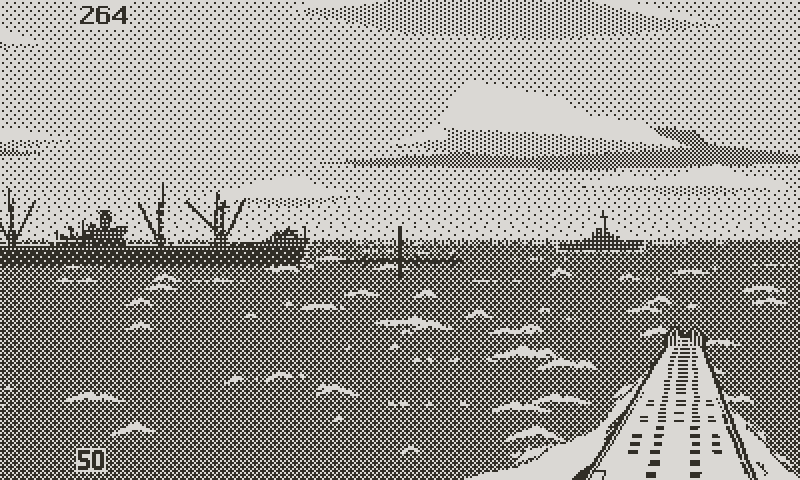
Giving the diving order in Atlantic ’41
But research tells a different story, and exposes the inherent dangers of navigating below the surface. Unlike modern submarines, U-boats were temperamental and dangerous machines; anything could go wrong at any moment, and underwater mechanical issues came with a high price. Not only that, but even proper operation of a functioning boat required experience and deep technical knowledge.
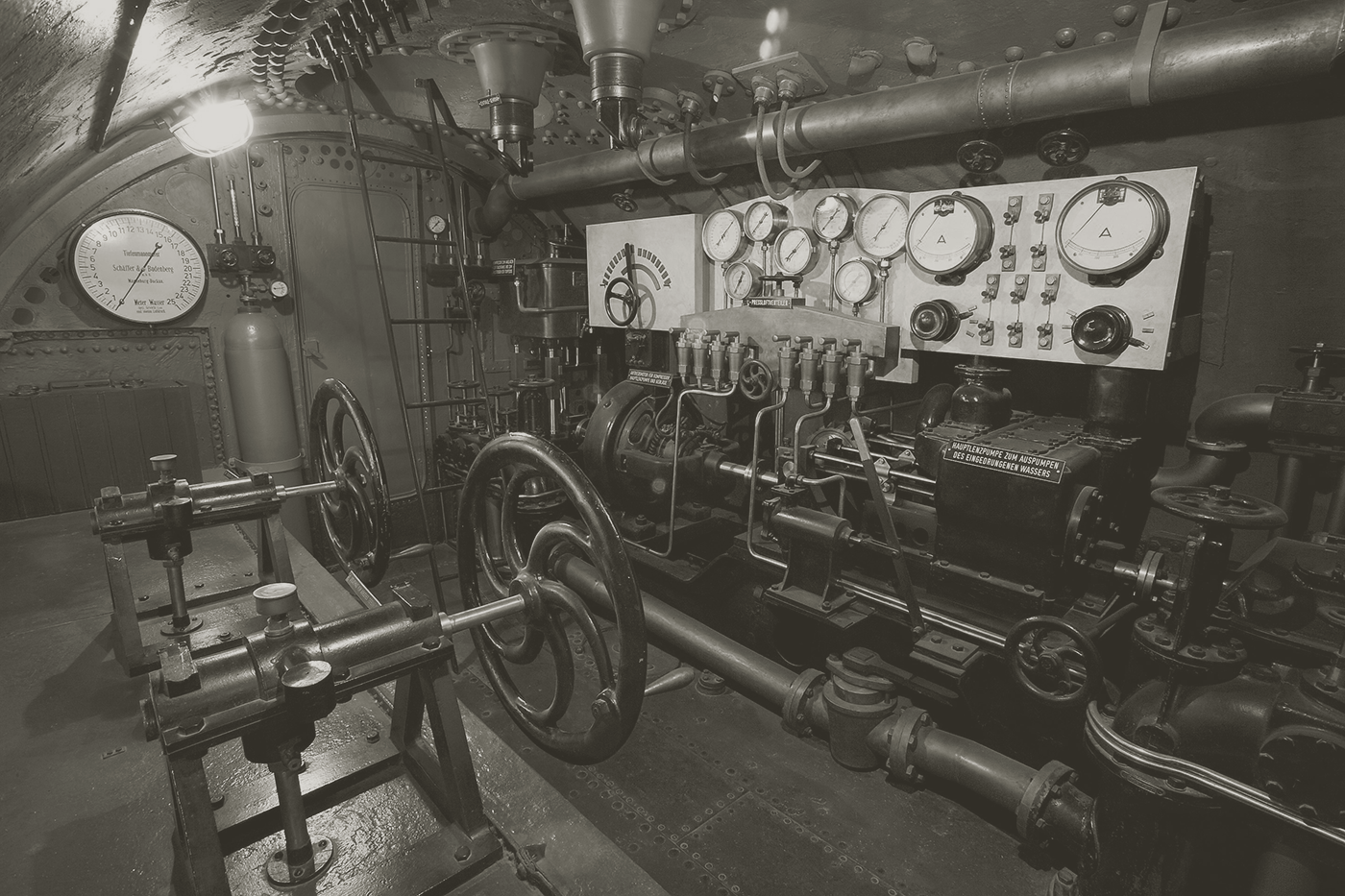
Control room of U-1, the first attempt at a German submarine
Besides, U-boats were designed to operate primarily on the surface, where they spent most of their time. They barely deserved the submarine designation by modern standards. Current submarines can remain submerged virtually indefinitely, creating their air and fresh water on their own nuclear power for months if needed. But WW2 subs are more aptly described as submersible boats. Even their name suggests that fact; U-boat, in German U-boot, means Unterseeboot (under-sea boat). Unless obligated, the boat was always on the surface, where mistakes and technical issues didn’t carry a potential death sentence. The Official U-boat Commander’s Handbook even recommends the night surface attack whenever possible.
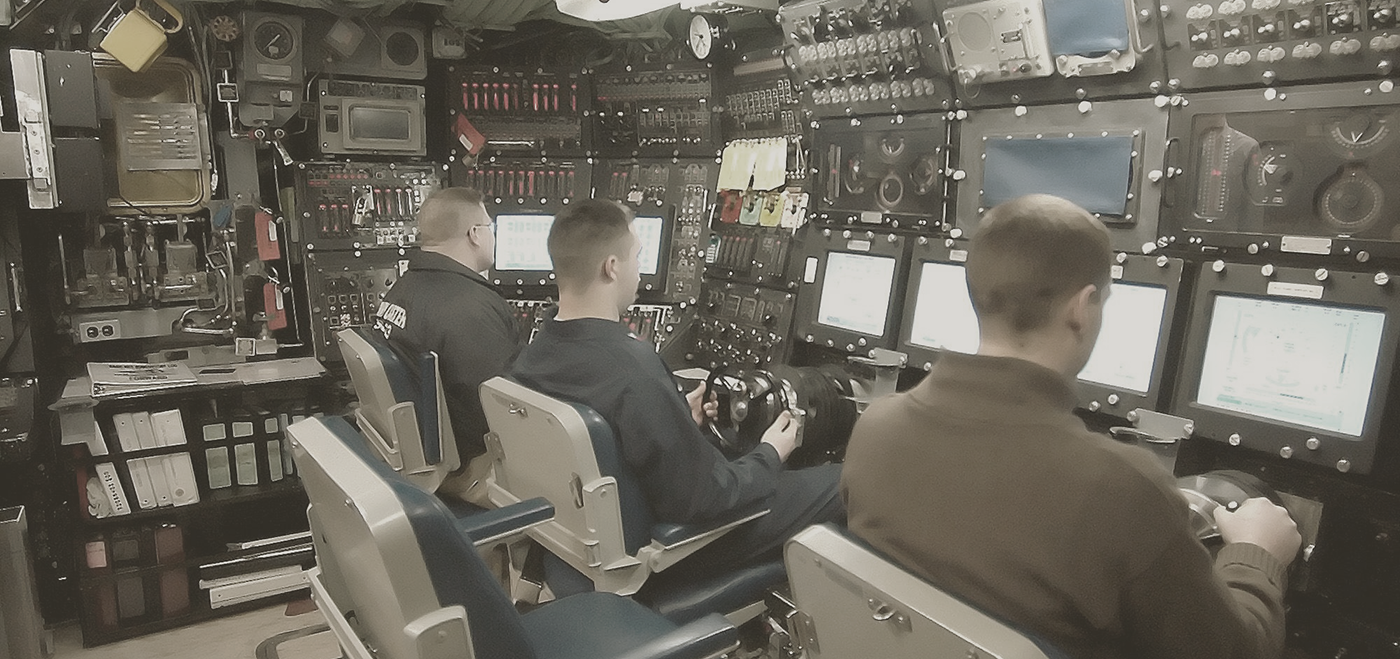
What difference 100 years make. The control room of the Seawolf Class nuclear submarine USS Jimmy Carter
Accounts convey this singular paradox; the deep is an essential ally to the men, but it can turn on them. This conflict appears in every aspect of life aboard:
/ Diving offers the element of surprise to the U-boat, but switching to the slow electric motors cripples it.
/ Daily trim dives give a moment of respite from the frequent battering of the elements, but calm is paid with the discomfort of stale air, humidity, and extreme temperatures.|
/ Deep diving increases chances of throwing off the ASDIC, beneath thermal layers, but higher pressure implies more stress on the superstructure and the pressure hull.
/ The deeper the boat, the less likely depth charges are to hit, but the boat gets heavier and can get dragged deeper than intended. Engineers losing control of a dive wasn’t as rare as you’d think.
/ Below periscope depth, the boat is blind, with the hydrophone as the sole way of guessing surface threats.
/ Underwater, no communications are possible, preventing the commander from sharing tactical knowledge with the rest of the Wolfpack, and making him unaware of his orders.
/ I explained long ago how accurate navigation required regular star or sun fixes, which require surfacing.

UC-5, an early German WWI U-boat, captured in 1916
Even a partial list of all the risks and issues is enough to understand the difficult balancing act of successfully commanding a U-boat. Like a famous fictitious commander once said: “In the service, one must always choose the lesser of two weevils.”
I’ve read fascinating stories demonstrating the numerous ways diving could save a U-boat, or doom it. Their complexity left inexperienced crews at the mercy of unforgiving mistakes. This was a problem as war went on, since by 1943 almost all aces and veteran commanders had been captured or killed.
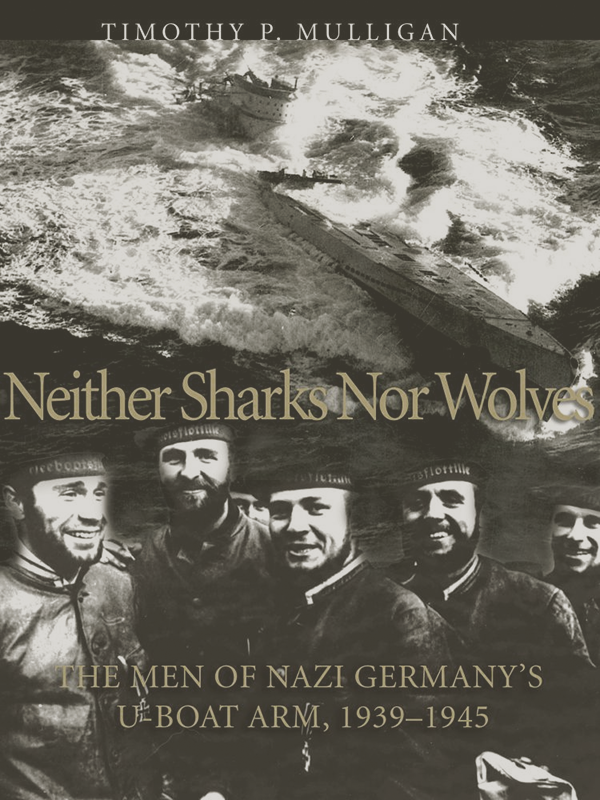
“Neither Sharks Nor Wolves”
Young officers with poor training and little to no combat experience were put in charge of boats, often making fatal blunders. In fact, from mid 1943, a non negligible proportion of boats were lost during their first patrol to crew error instead of enemy activity.
In “Neither Sharks Nor Wolves”, Timothy Mulligan talks about the danger faced by inexperienced crews. He says that “veteran crews were broken up to distribute their maturity and experience among the newcomers.” About the ace Günther Prien, famous for his bold raid on the British harbor of Scapa Flow, Mulligan writes: “By the time Günther Prien departed on his last patrol with U-47, he retained none of the officers and only seven of the crewmen who had accompanied him on the Scapa Flow raid seventeen months earlier. From his last war cruise neither the veterans nor their thirty-seven new shipmates returned, quite possibly victims of the inexperience of so many crewmen.”
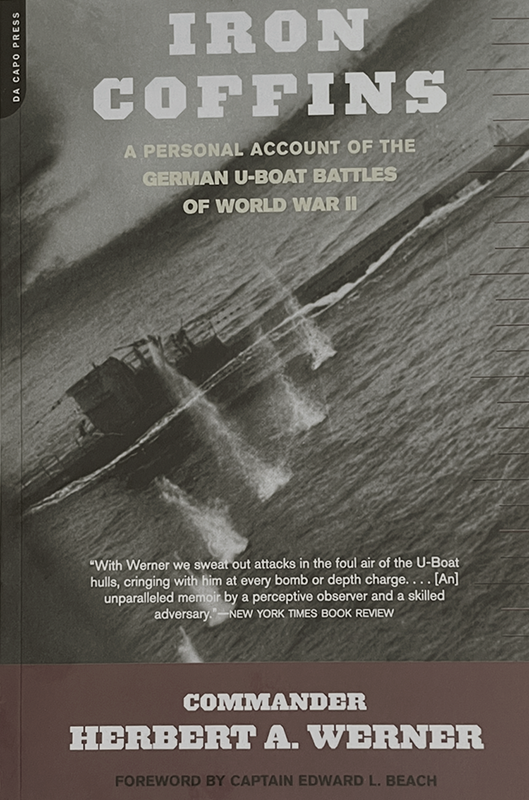
“Iron Coffins”
In his book Iron Coffins, Herbert Werner tells of the terrifying close call he experienced during his first patrol as a young ensign. A trim dive took a dramatic turn because of a mere wrench stuck into a diving plane valve. The crew spent 14 hours at the bottom trying to repair the boat in a desperate battle for survival.
Flushing high-pressure toilets challenged the best technicians: on April 14, 1945, U-1206 became a victim of a misused head, which caused large amounts of seawater to flood the boat. The leak spilled into the batteries, generating deadly chlorine gas, which forced emergency surfacing in order to vent the boat. U-1206 was then bombed by British patrols, forcing the commander to scuttle the submarine. Three men drowned as they evacuated, and 46 were captured.
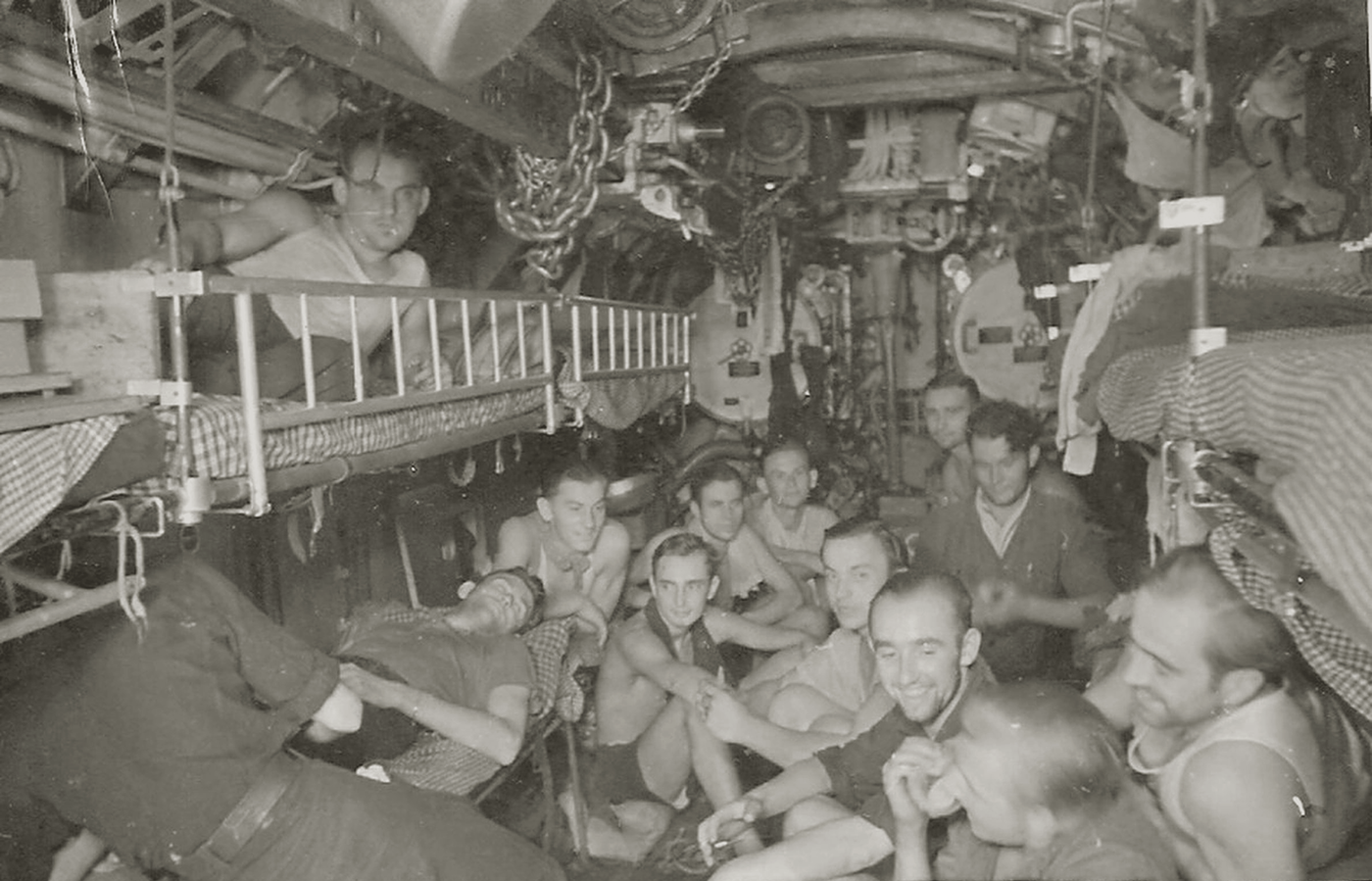
The stench aboard U-boats was so terrible that repair crews could barely bear to step inside
This opens an interesting topic about crew experience and morale, but this is a discussion for a later time. For now, what transpires is that a simulation could reflect the non trivial and dangerous nature of the job even outside of conflict. And also that situations were rarely black or white; Submariners often stood at the edge of the precipice, and the game could try and convey this grey area. Getting stuck at the bottom for hours, not knowing if you’ll ever be able to surface, is a dramatic and iconic U-boat situation and surely there’s something to exploit there.
Now I’m not suggesting that catastrophe should strike every dive. In fact, things will work out fine in most cases, assuming that you have a good crew and a well maintained boat. But successful diving should never be a guarantee. I want to plant in the player’s mind the possibility of an incident lurking at any time, even outside combat.
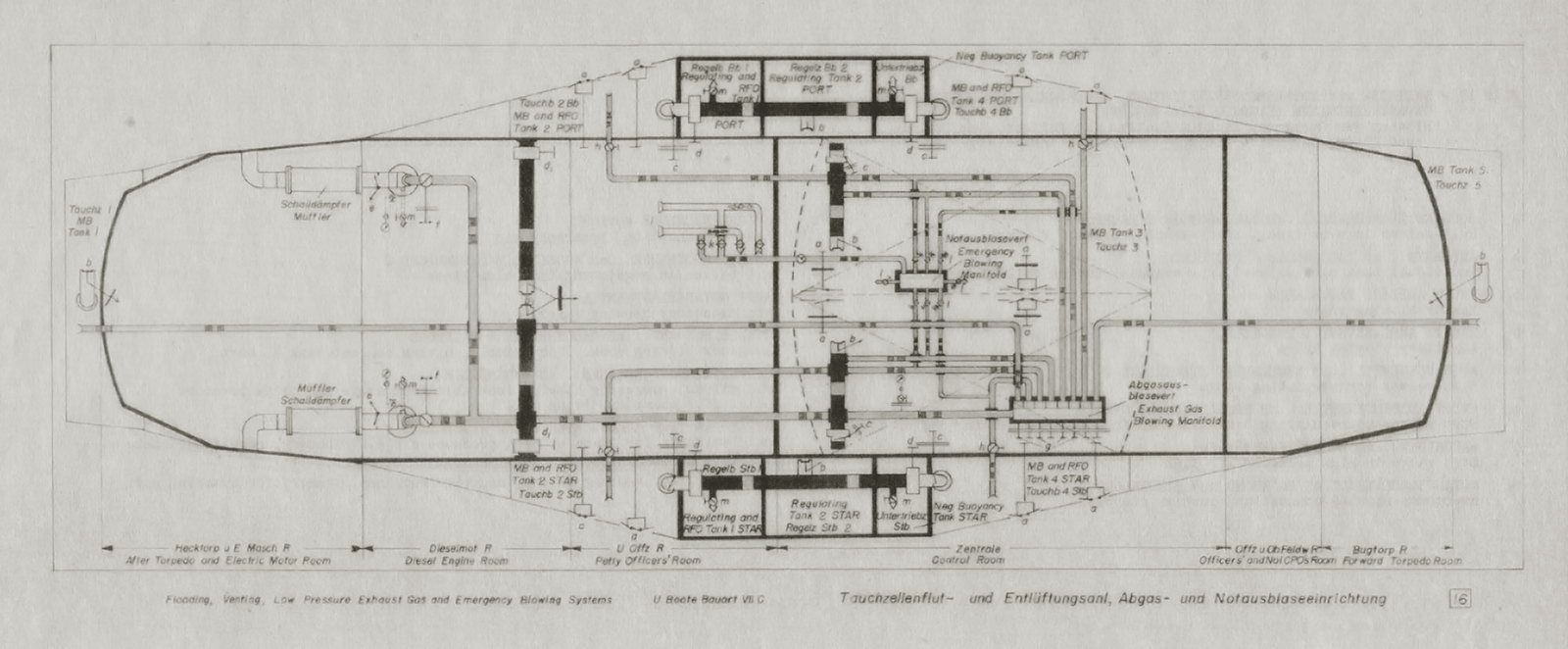
The type of diagram the engineer had to understand, here just for the ballast tank flooding and venting system of a type VIIC.
But for this risk/reward gameplay to work, I need a way to emphasize the significance of diving, and to make it an exciting and stressful event, of which a successful outcome can’t be taken for granted. And I figured that now would be the time to explore this, since diving/surfacing will be the first action resolved as part of the end of turn sequence.
The Right Perspective
Now as I mentioned, the excitement and anxiety related to diving can only come through with the help of a dedicated feature, which will trigger during the end of turn sequence, in the eventuality that the commander ordered a change of depth for that turn.
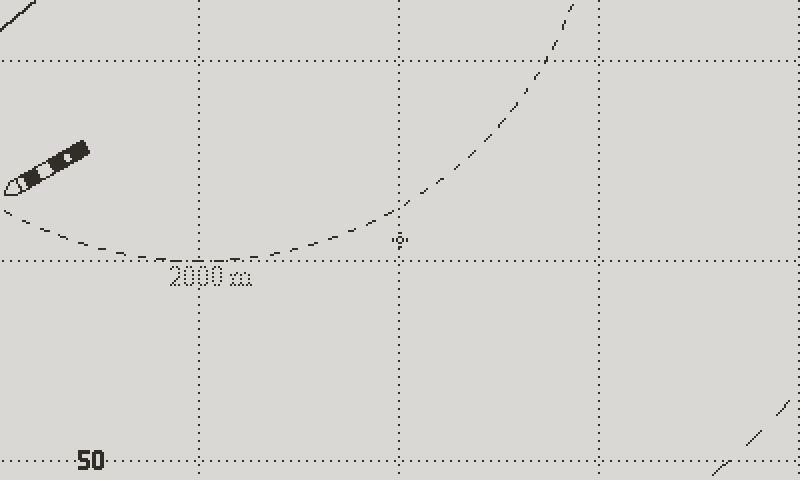
The title cards of the end of turn sequence
I thought of many different ways to showcase that event, from a pre rendered animation, to a sequence of still images presented in a dynamic way, in the vein of a comic book. But this presents several issues; first, animations or illustrations tend to look great until the novelty wears off. After a while they turn into a predictable, mandatory chore that the player can’t wait to skip.
In addition to that, I was concerned that the animation could feel somewhat disconnected from the rest of the game, going through the same motions regardless of the situation. Not to mention the chance of a tonal disconnect, as cinematic presentations may give a lighter, more action oriented tone, which feels inappropriate to a WW2 simulation.
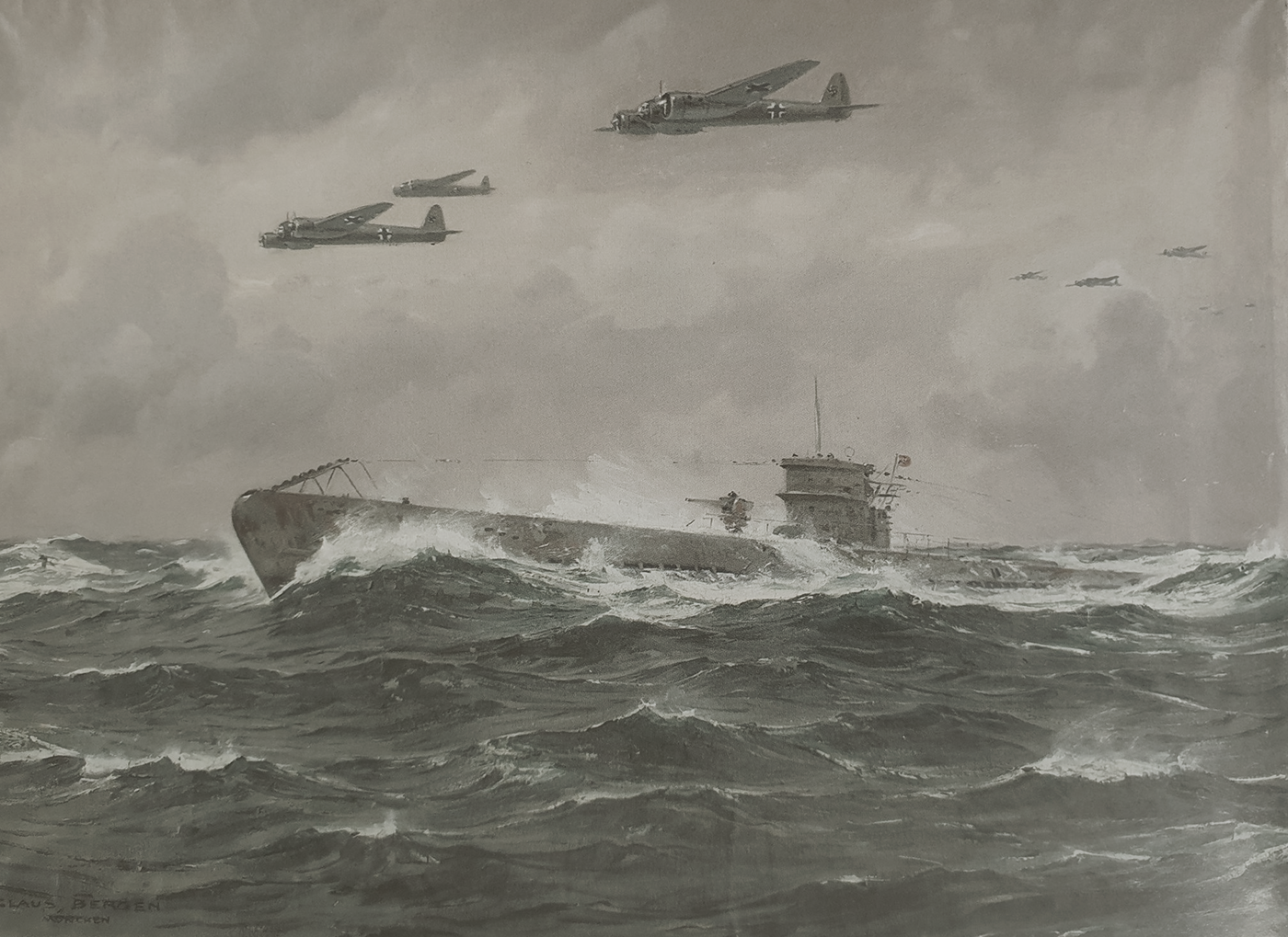
“U-Boat VII C in heavy seas with JU88 squadron”. Claus Bergen
To alleviate the problem, the sequence must have a varying and unpredictable pace. And the logic wants to link it to the parameters of the dive; it would make sense that a long dive to 150 meters looks and feels different than surfacing from periscope depth.
A real time sequence is easy to imagine in the context of a modern PC simulation. Games like Uboat have full 3D engines allowing them to set up spectacular views of the submarine as it descends into the deep. They can track around the boat, glide along the sea bed as it reaches dangerous areas. The possibilities are endless, and that game always looks gorgeous. But there’s a flip side to this. In spite of all their advantages, it’s worth questioning virtual cameras in simulations. In particular vehicle simulations, and even more so submarines.
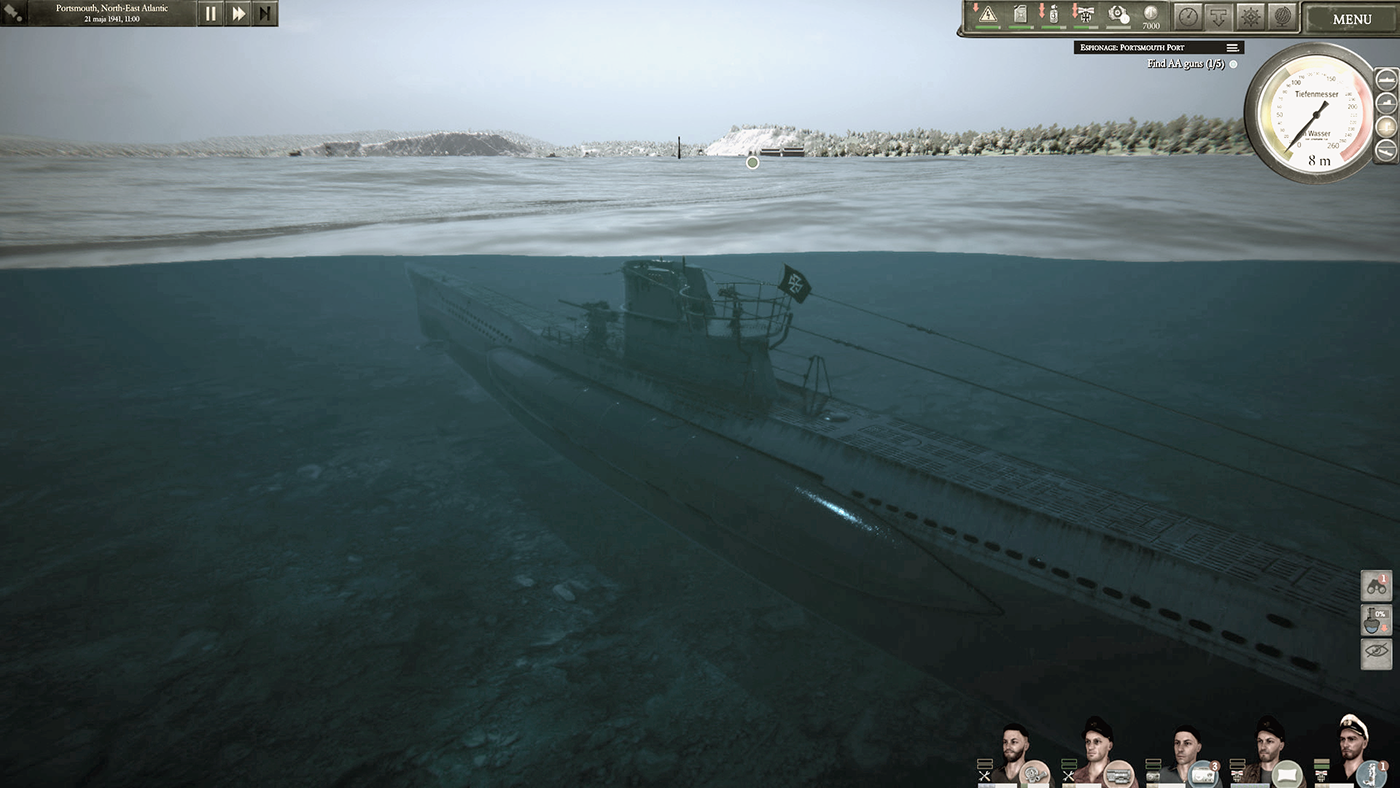
Shallow waters in “UBOAT”
I can’t help but to think that stepping outside the U-boat hurts immersion. The claustrophobic, blind perspective is a defining aspect of the U-boat experience, in which men can only listen for clues of the world outside. Their entire universe is reduced to their immediate surroundings, with the commander getting the occasional privilege of a glimpse at the action through the attack periscope. I don’t think that it’s a coincidence that there’s so few outside underwater shots of the U-boat in “Das Boot”, which I’ll come back to in shortly.
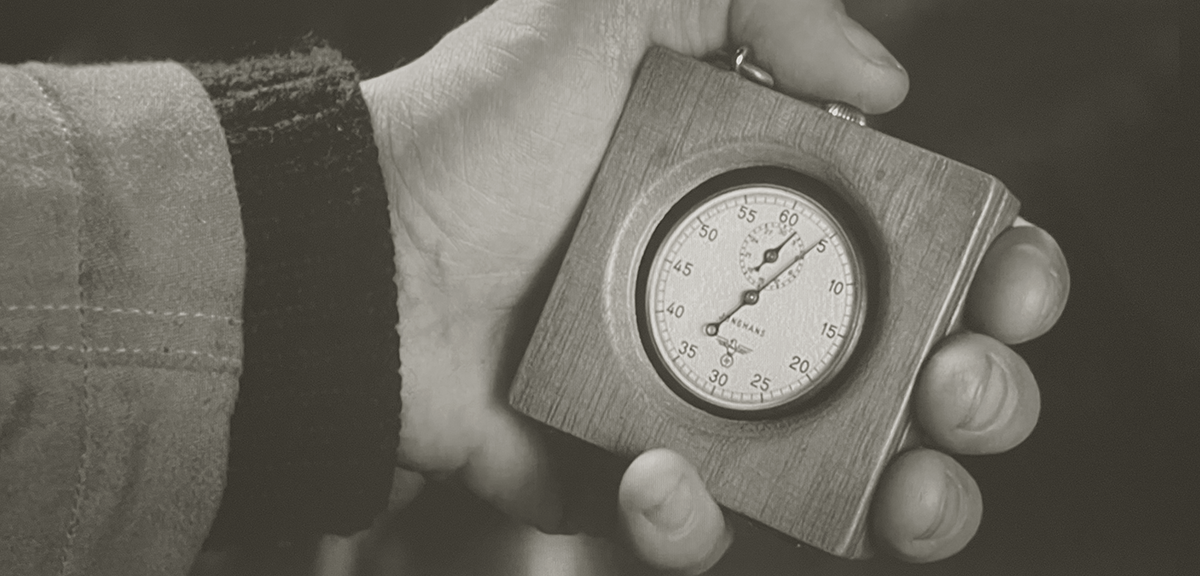
A stopwatch was the only way to estimate torpedo progression
I understand the appeal of showing off the spectacular impact of a torpedo on its target. I may have gone that route, had I the skills and the proper platform. But I wonder if seeing the torpedo on a perfect trajectory doesn’t rob the player of an intense suspense as only the ticking of the stopwatch breaks the silence of the last few seconds before the anticipated deflagration.
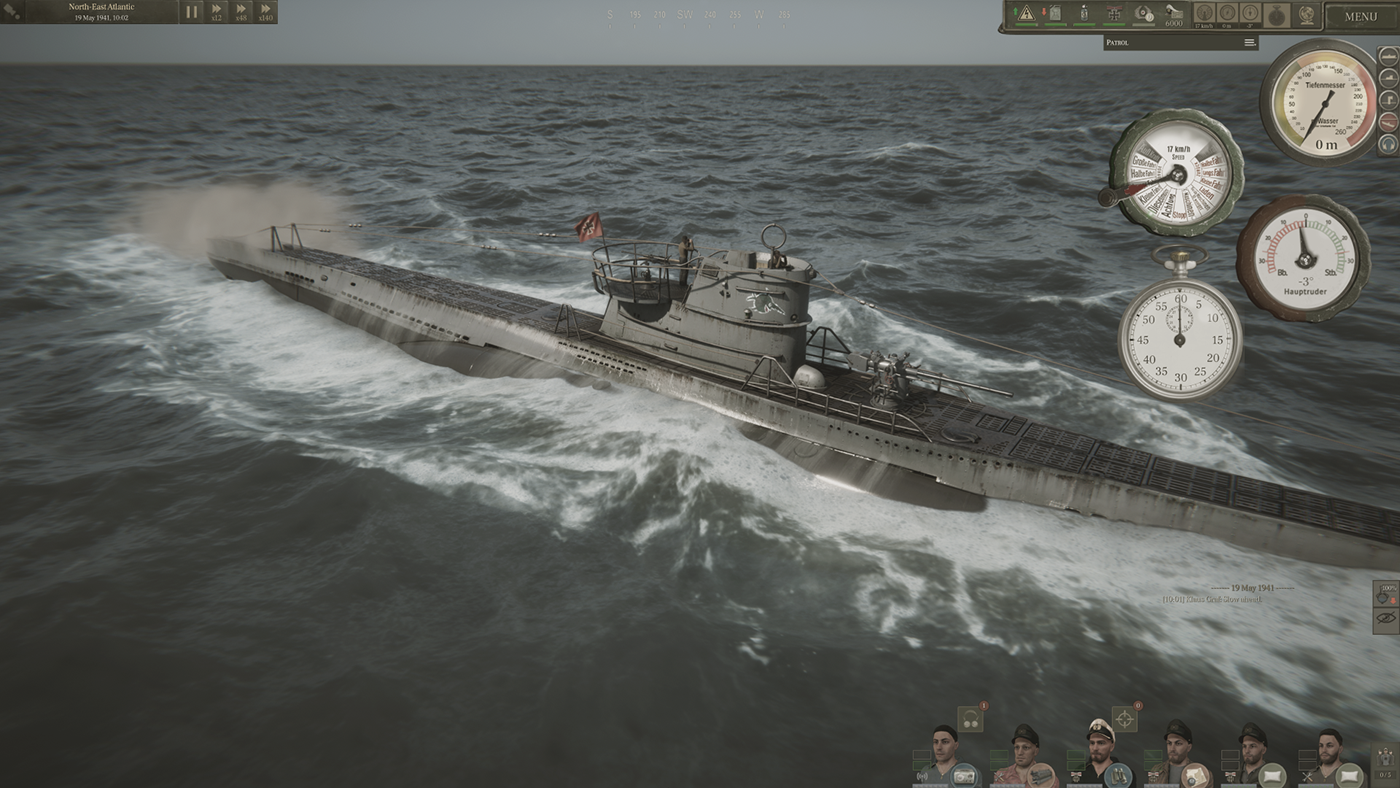
Spectacular ocean simulation in “UBOAT”
This goes for diving too. Being unaware of the configuration of the underwater landscape makes the descent a more stressful experience. The possibility of a destroyer waiting in silence on the surface to catch you off guard changes your feelings as you ascend. That uncertainty was a constant lot, and as much as I like seeing my U-boat in full 3D glory, it may take away an important feeling of the simulation.
Truth is, I don’t have the production values that could justify making that trade off, so it’s best to embrace the limitation as part of the game’s philosophy; commit to the idea of full immersion. This means that the player should never get more information than what they would normally have access to in a realistic setting.
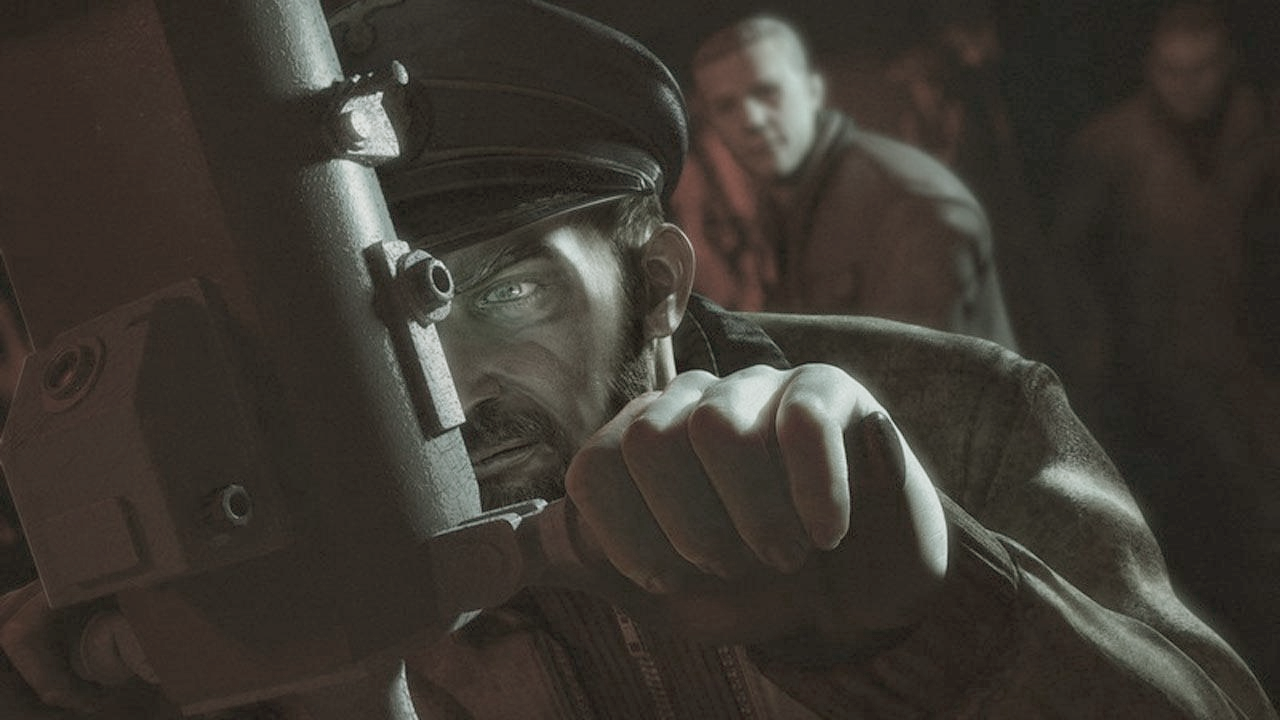
A cinematic sequence in “Silent Hunter 5”
A few examples: if you fire torpedoes, the only indication of a hit is the explosion through the periscope. In the case of a miss, the hydrophone operator can sometimes confirm the dud hitting the target’s hull, but only with the boat’s engines off. Below periscope depth, listening to the hydrophone is the only way to know about escorts.
When depth charged, you don’t know which ship is attacking, nor how much ordnance they have left. If the chief detects a mechanical weakness, consequences may vary. The part may fail in a day, or a week, or it may not fail at all. In fact, damage may not be immediately obvious; an aircraft bomb could have damaged the diving planes, which you’ll remain unaware of until they jam during descent. Until the weather allows to take a star or a sun fix, the location of the boat can only be estimated through dead reckoning.

U-boat damage table in “The Hunters” board game. Damage never occurs outside of combat
Enemy activity (course changes, firing) is the only clue that the U-boat has been detected. Maps have approximate water depth information, and only an echolot ping can yield accurate results. So you have to make the decision of risking detection using the Echolot, or dive blind. regarding depth under keel, reality was a bit more complex to be fair, but the game simplifies the process.
I love all this uncertainty and suspense. To me, it’s at the core of all the great War stories, where nothing ever goes as planned, and success is a combination of resilience, adaptation, and sometimes plain luck. There’s a reason why FUBAR was coined in the army. And if operation Overlord, on June 6th, 1944, is an indication, even the best plans can fall apart. From the weather, to the tide, to the intel, D-day was a prime case of Murphy’s law. And what began as a disaster was bent into a victory under the sheer determination, courage, and experience of the men on these beaches (with a nudge from Lady Luck or the Man above, depending what you believe).
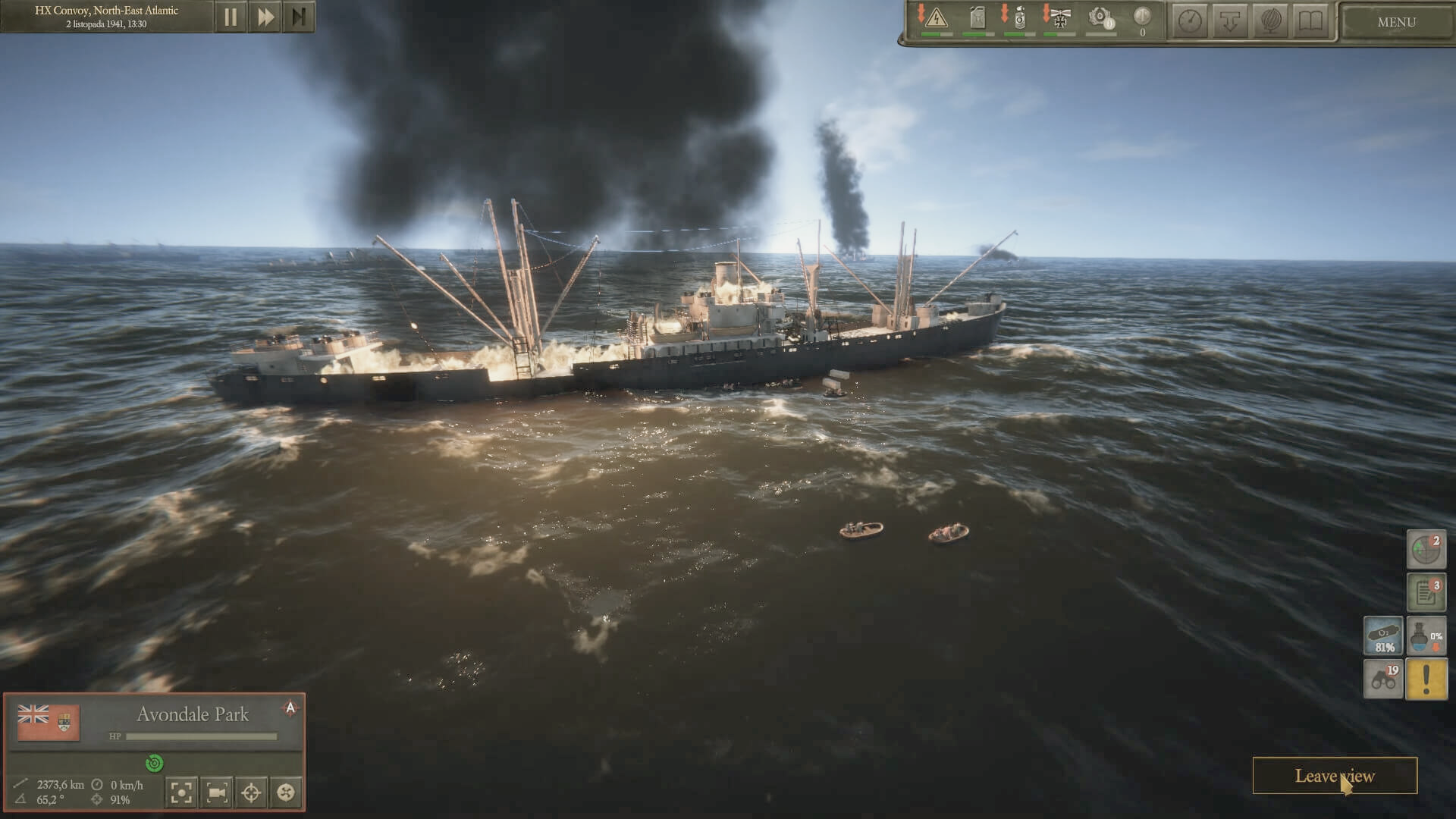
Target camera in “UBOAT”
To me, there’s something beautiful about the idea of fighting adversity, even more than the enemy. It’s when you must make a life or death decision with incomplete information. It’s when shit hits the fan and the crew pulls together to turn fate around. And I feel that if the game doesn’t shy away from taking a hard stance against holding the player’s hand, in particular in a wartime simulation, it sets up opportunities for them to feel like heroes.
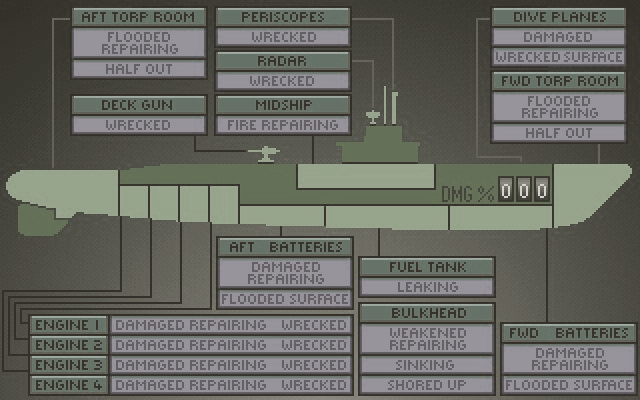
Silent Service damage screen
It’s a bet, no doubt. Having a hard time isn’t everyone’s idea of having a good time. But looking back at the games I love, I see how they all committed to a vision, even at the risk of alienating players. There’s plenty of great U-boat simulations out there, many of them offering better production values, detailed procedures, and more content than I can ever hope to achieve.
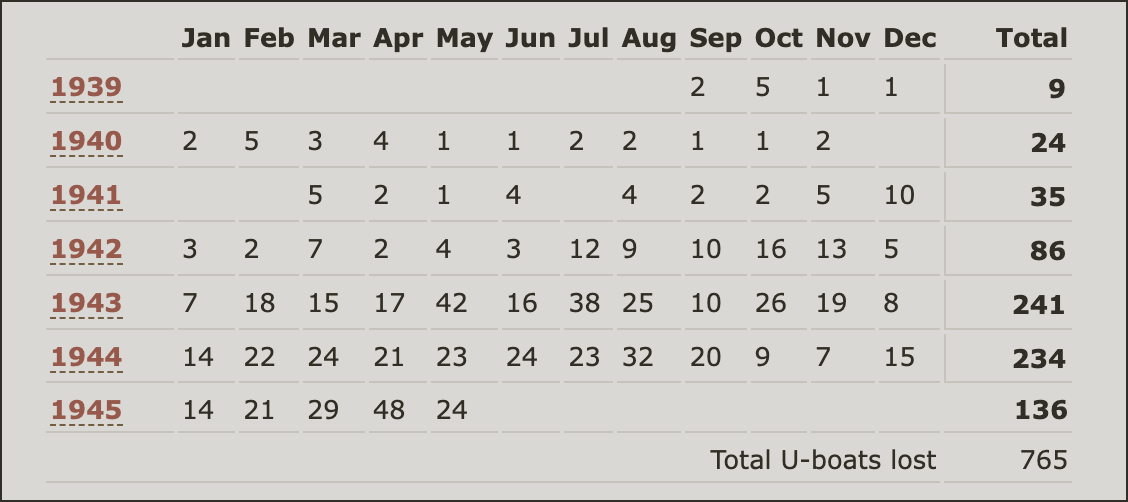
Numbers show the 1943 spike in U-boats losses
But Atlantic ’41 can at least attempt to propose a less “video game”, more subjective perspective with a focus on psychological tension and an uncompromising challenge. Being the underdog, under immense pressure, often blind or crippled, may not be for everyone, but I’m convinced that it makes the player’s successes sweater, the learning more rewarding, and the long, uneventful patrols an even more powerful contrast (You can refer to this log to know more about this idea in particular - Devlog 2)
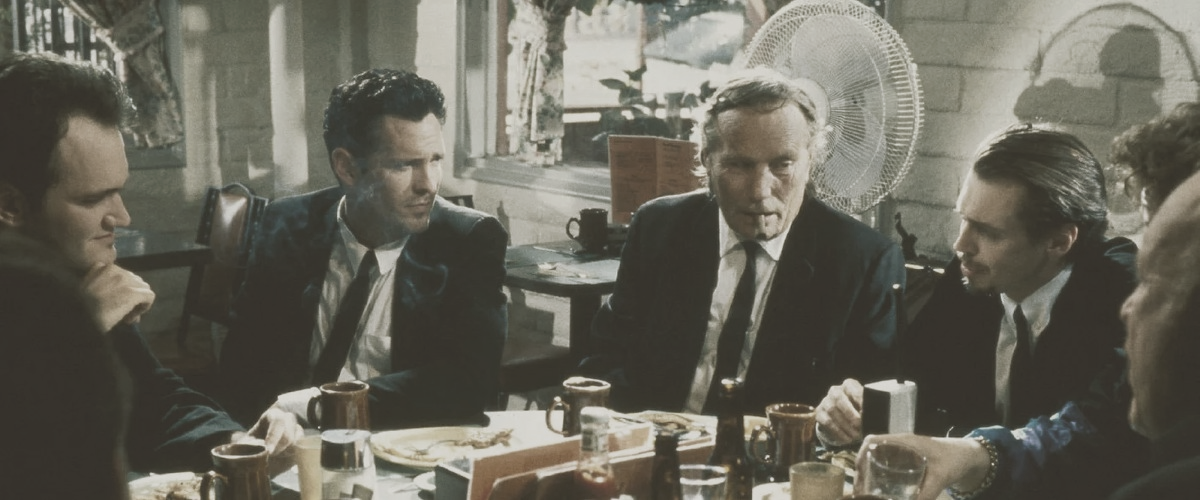
“Reservoir Dogs”. How to build a memorable scene with a table and a fixed camera.
Not only that, but this mindset anchors the game to a consistent vision. I can look at every feature and situation through the lens of the U-boat commander, instead of focusing on the cinematic spectacle. I think of it as a low budget film. When Tarantino makes Reservoir Dogs, he knows that he can’t afford the big action set pieces and stunts, so a large part of the story revolves around a handful of characters in a warehouse. He uses the tools at his disposal to build a unique vision based on his talent for dialogue and a clever premise. Forgive the clumsy analogy; to be clear, I don’t compare Atlantic’41 to Reservoir Dogs, not I to Tarantino.
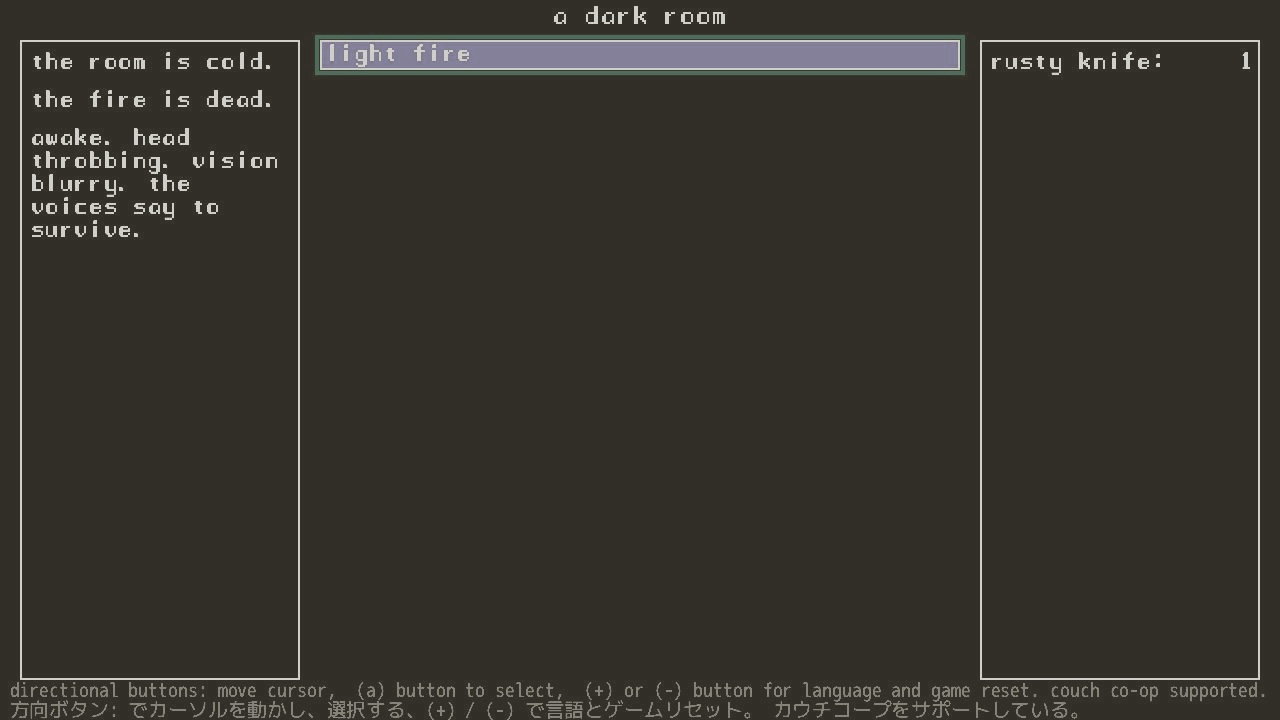
“A Dark Room”
I can think of amazing use of limited resources in video games too. “A Dark Room”, in spite of ASCII art and simple mechanics, delivered an experience that stayed with me long after it was over. I can mention Lucas Pope’s “Papers, Please” (whom I admire very much, in case previous logs didn’t make this obvious). Tapping into the universal themes of family and responsibility, he managed to make us care for folks that are never even shown.
It’s an inspiring mindset for Atlantic ’41; to try and set up a strong tension throughout the game in a way that resorts on the player’s imagination, rather than spectacle and action. In other words, to suggest, with a sense of economy.
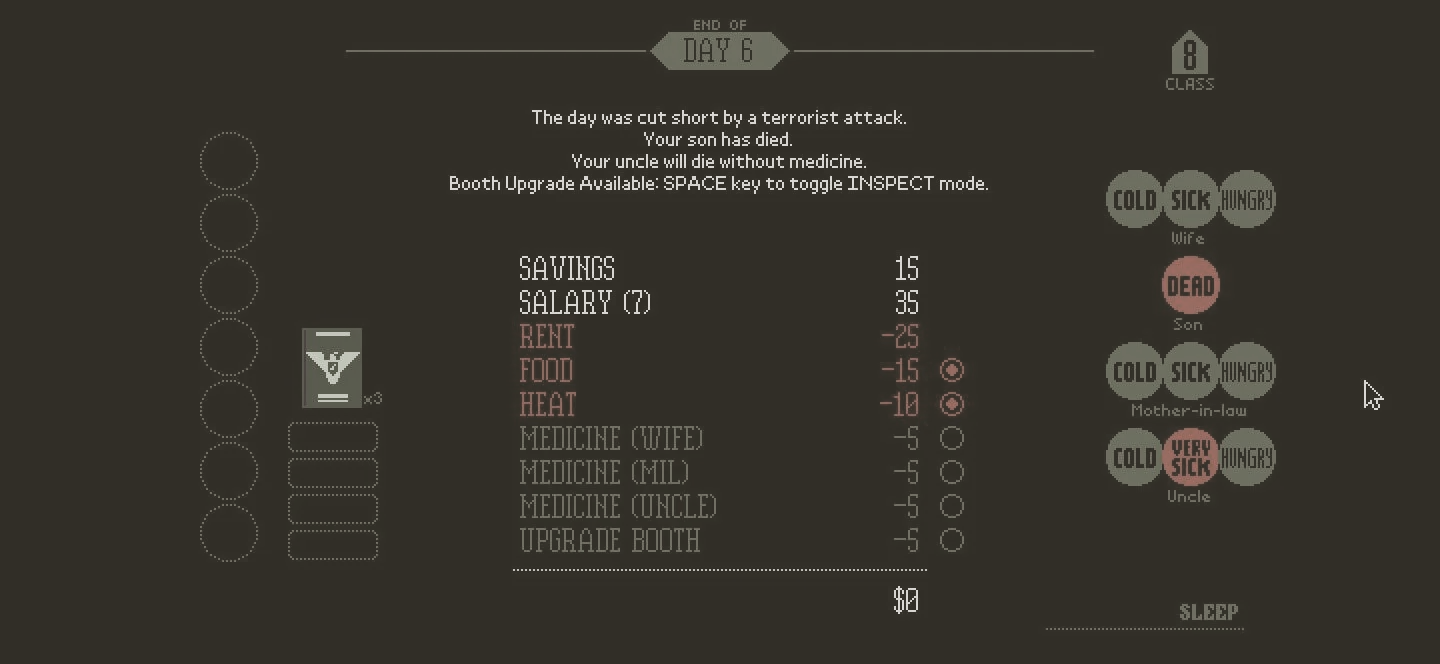
“Papers, Please”
Boat is Beyond Control
How would that apply to the diving sequence? In “Das Boot”, diving is the moment when everybody gathers around the depth gauge in the command room, their eyes locked on the pointer.
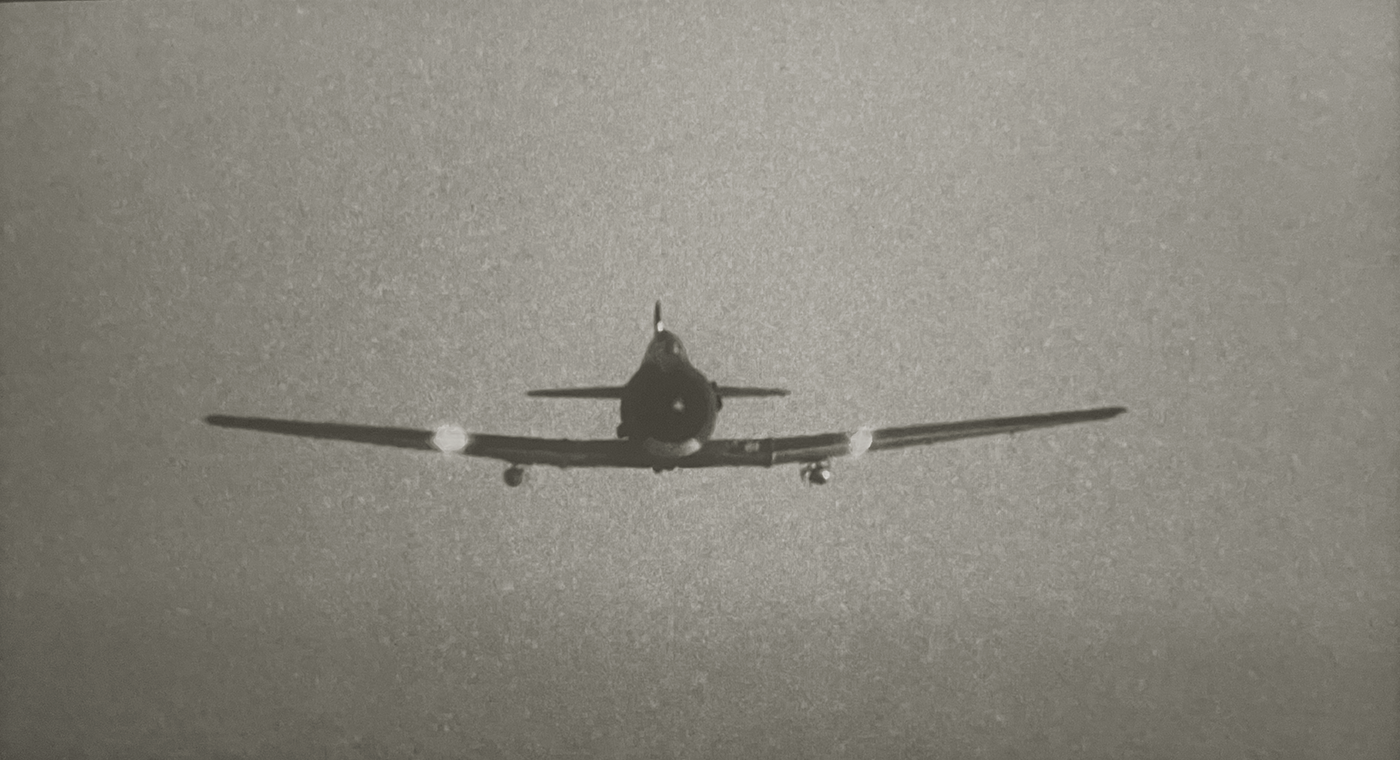
A tense scene illustrates the symbolic power of the depth gauge, and its potential for the diving sequence. As she attempts to sneak undetected through the Strait of Gibraltar, U-96 is attacked by an aircraft, forcing the commander to order a crash dive.
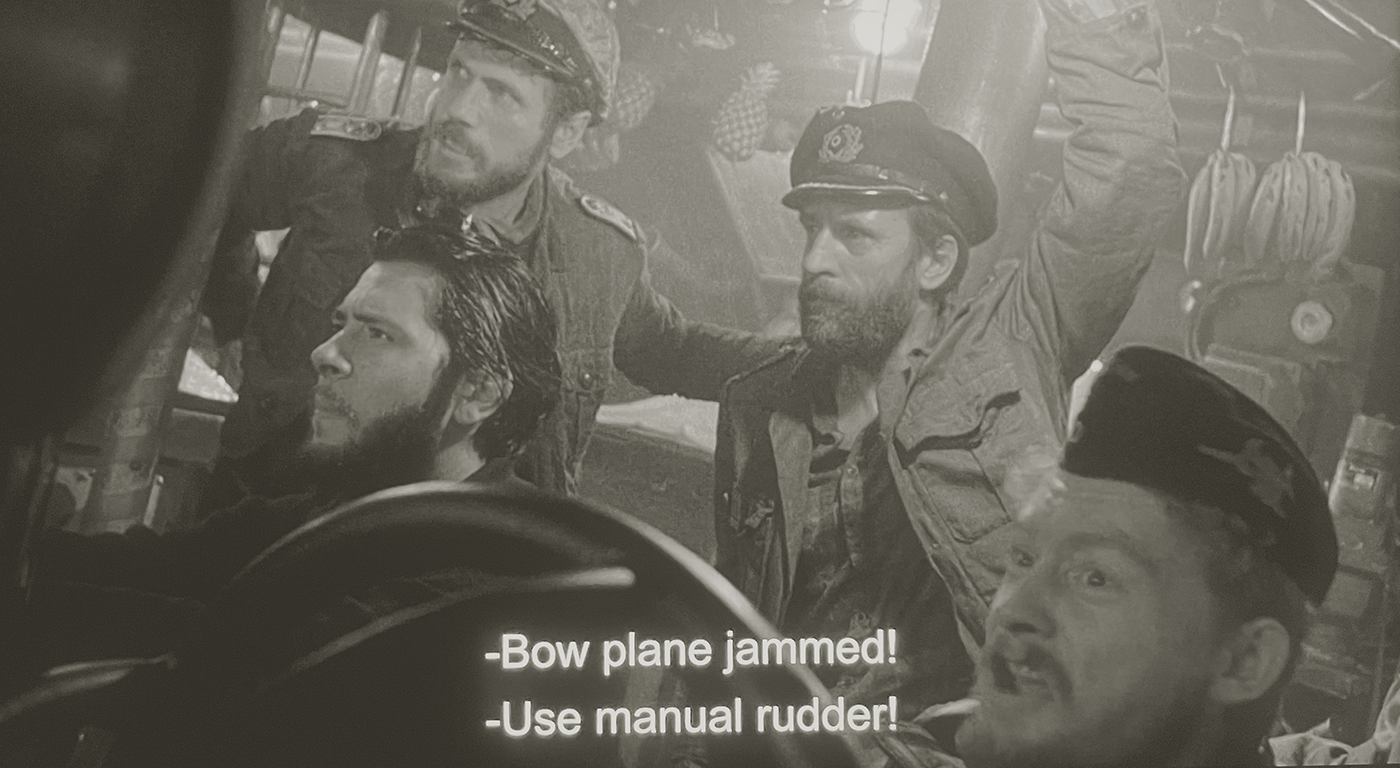
But damage jams the bow diving planes in full down position, sending the boat into a steep descent. Despite the men’s best efforts on the plane’s wheel, they can’t control the pitch. The Chief then orders all engines stopped, and the crew runs aft, hoping to shift the weight toward the stern.

As if the situation wasn’t bad enough, the ballast pump is down, which forces them to trim manually. As a last resort, the commander orders to blow the ballast tanks. This should lighten the boat by forcing water out the tank with high pressure air. They start with the bow tank, to no avail, before blowing all remaining tanks in a desperate move. Yet the boat keeps sinking as they all stare at the pointer of the depth gauge as it passes 150 meters, then 160, 170...
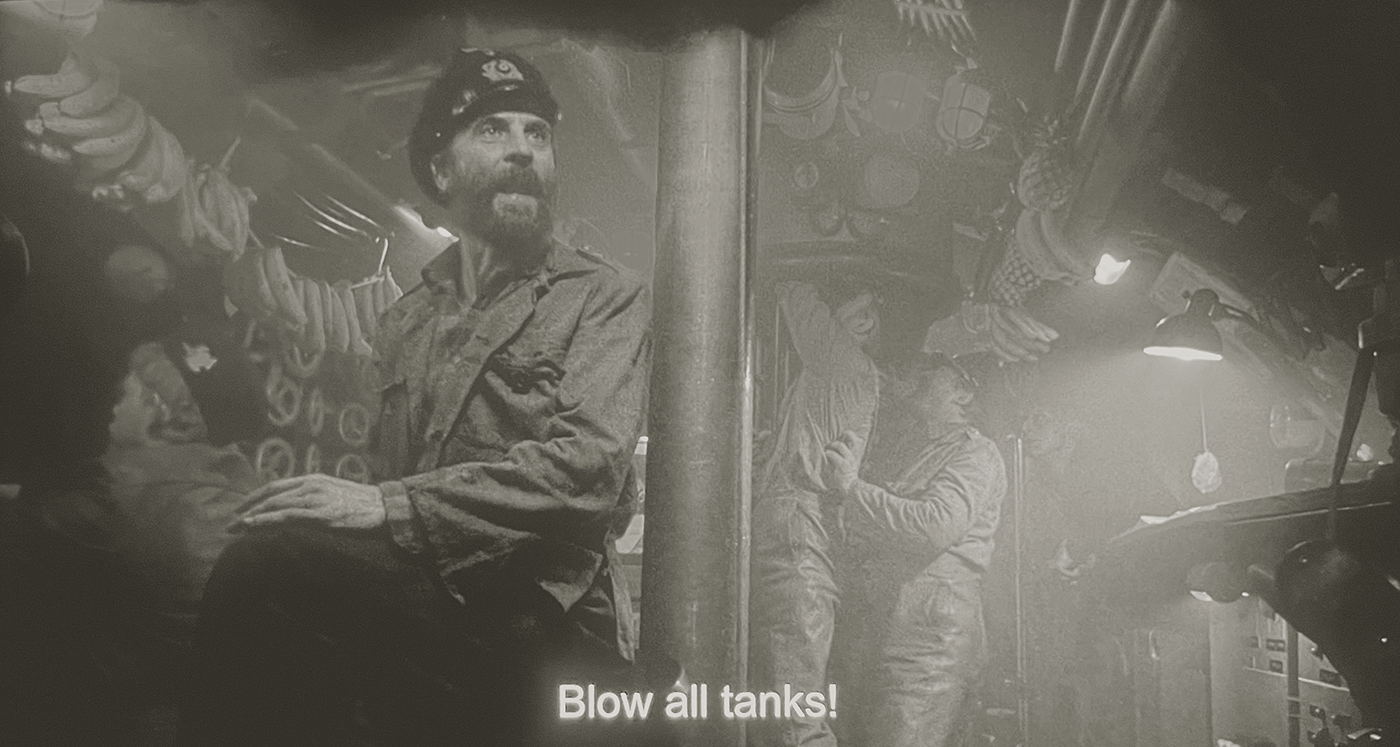
As they reach 200 meters, the Chief’s panicked expression shifts to a terrible resignation, and he utters one of the most memorable lines of the film: “Boat is beyond control.” It’s a fantastic scene, maybe the best of this masterpiece, which owes a lot to the acting, in particular Klaus Wennemann who plays the Chief Engineer.
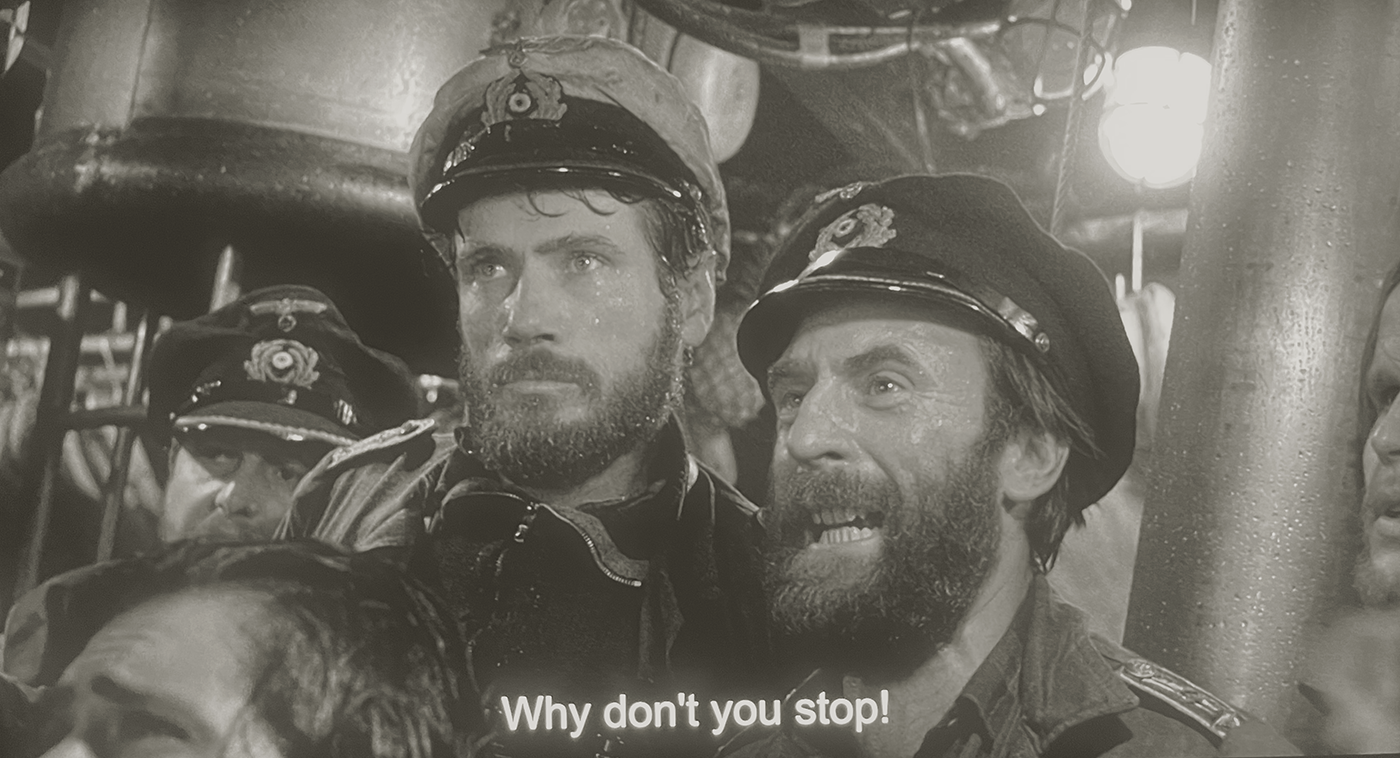
That scene makes the ideal template for the diving sequence. It revolves around the depth gauge and a series of comments and orders from the Chief and the Commander as they try to regain control of the boat. Putting this into context with the idea of Atlantic ’41 always showing the action from the crew’s perspective, I figured that I needed to put the player in front of the depth gauge panel, like if they they stand in the control room.
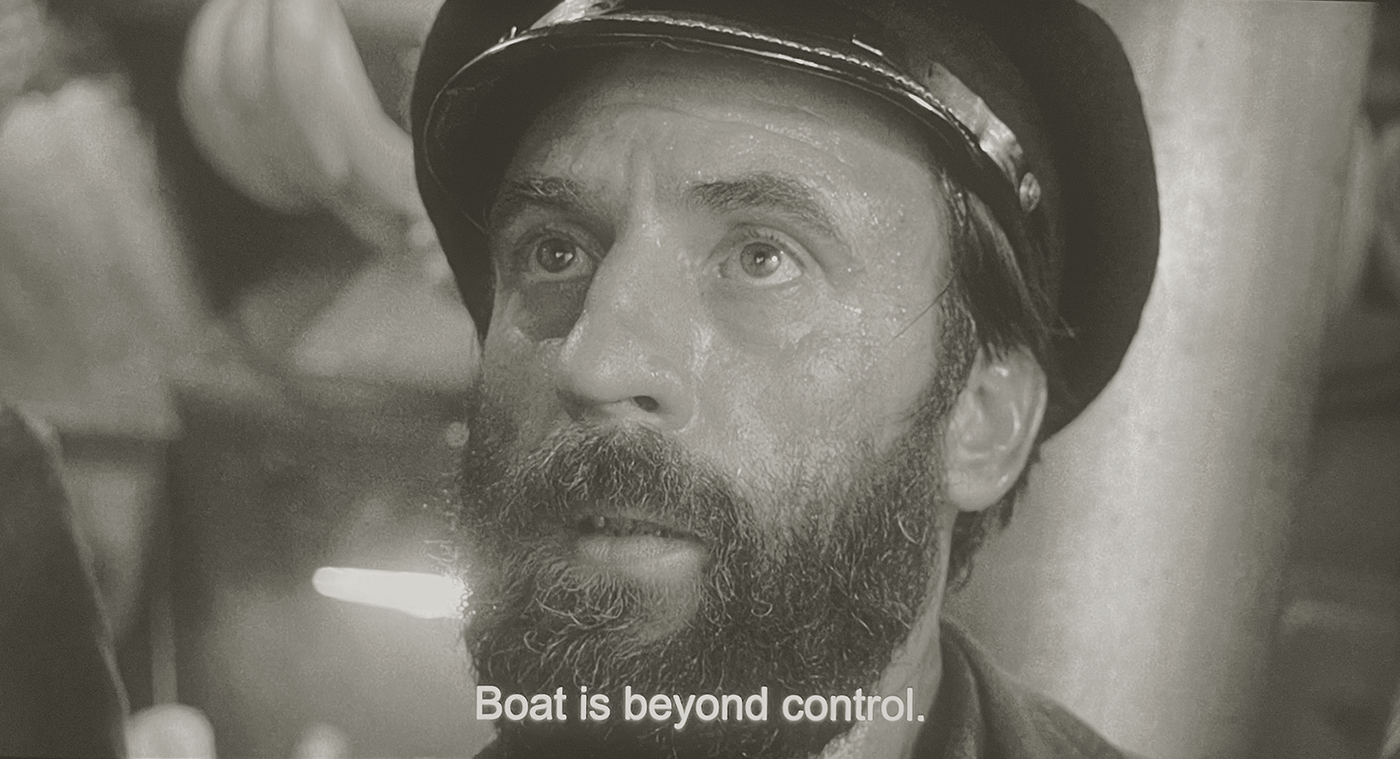
It’s a realistic, subjective point of view, which doesn’t give away information that the crew wouldn’t realistically have access to, like depth under the keel, or ships lurking on the surface.
As seen in the film (and like it must have happened in real life), the player surveys the progression of the dive in real time, hoping for the best. The Chief and the Commander comment events as they occur, with the Chief giving updates on damage and technical issues, while the Commander focuses on orders, discipline and morale, with occasional general comments.
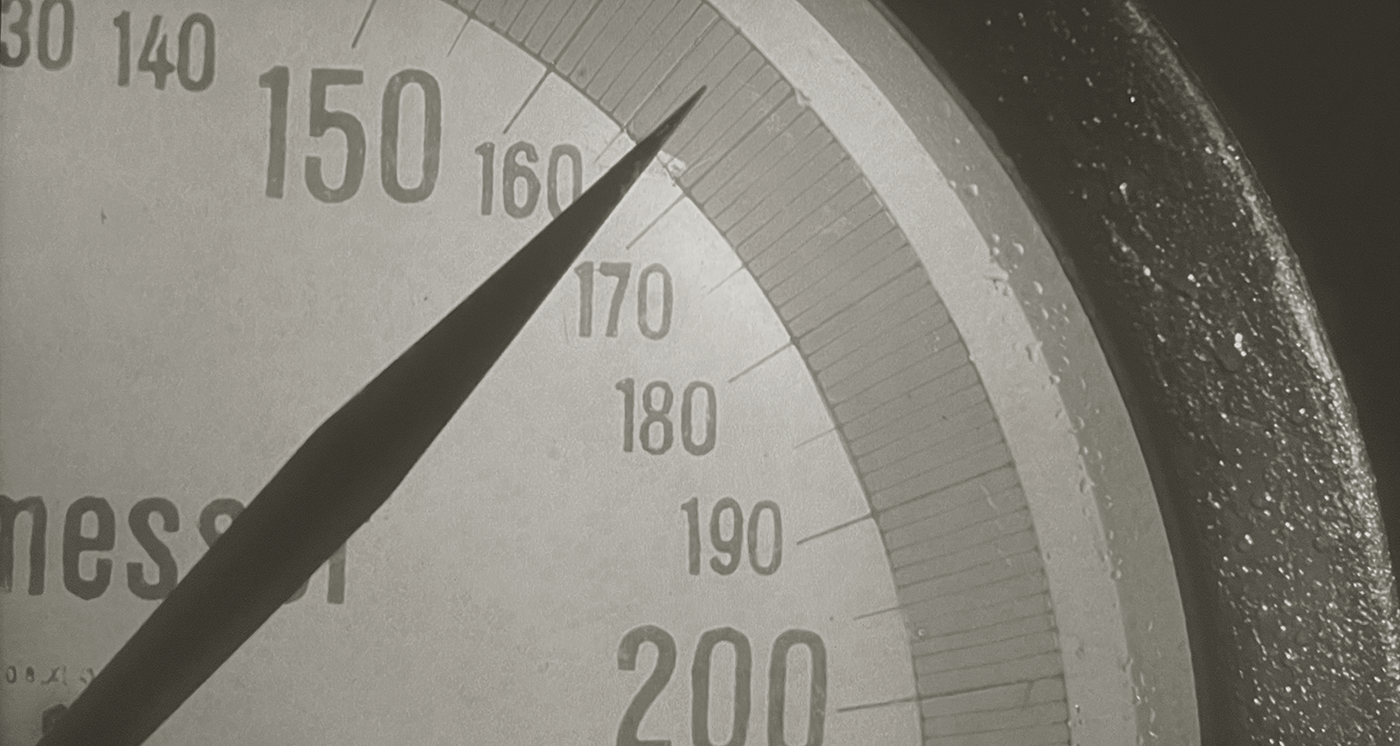
Even though I see the diving as essentially passive, I’m considering giving the player some agency on the Commander’s orders, in particular when trying to prevent catastrophe. For instance, as seen in “Das Boot”, the Commander must make a decision to blow the tanks early, or to give more time to the crew to unjam the bow planes. But this implies more technical knowledge from the player, and a feature growing both in scope and complexity.
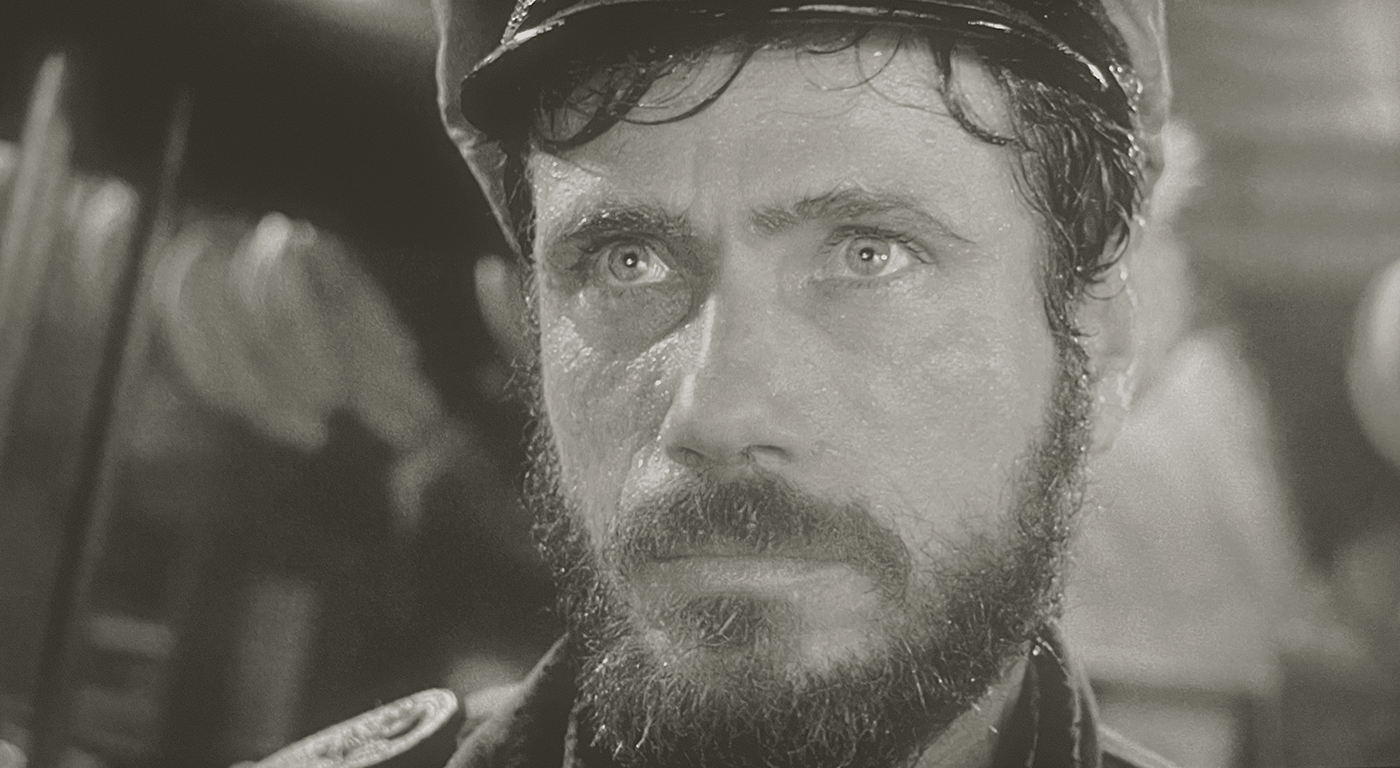
As with other aspects of the game, the best is likely to build a functional core first. At the moment I lean toward events unfolding without player’s intervention, the Commander making the best calls for each situation. The game already offers significant depth and complexity for a light simulation, and I’m not even close to having implemented everything I want.
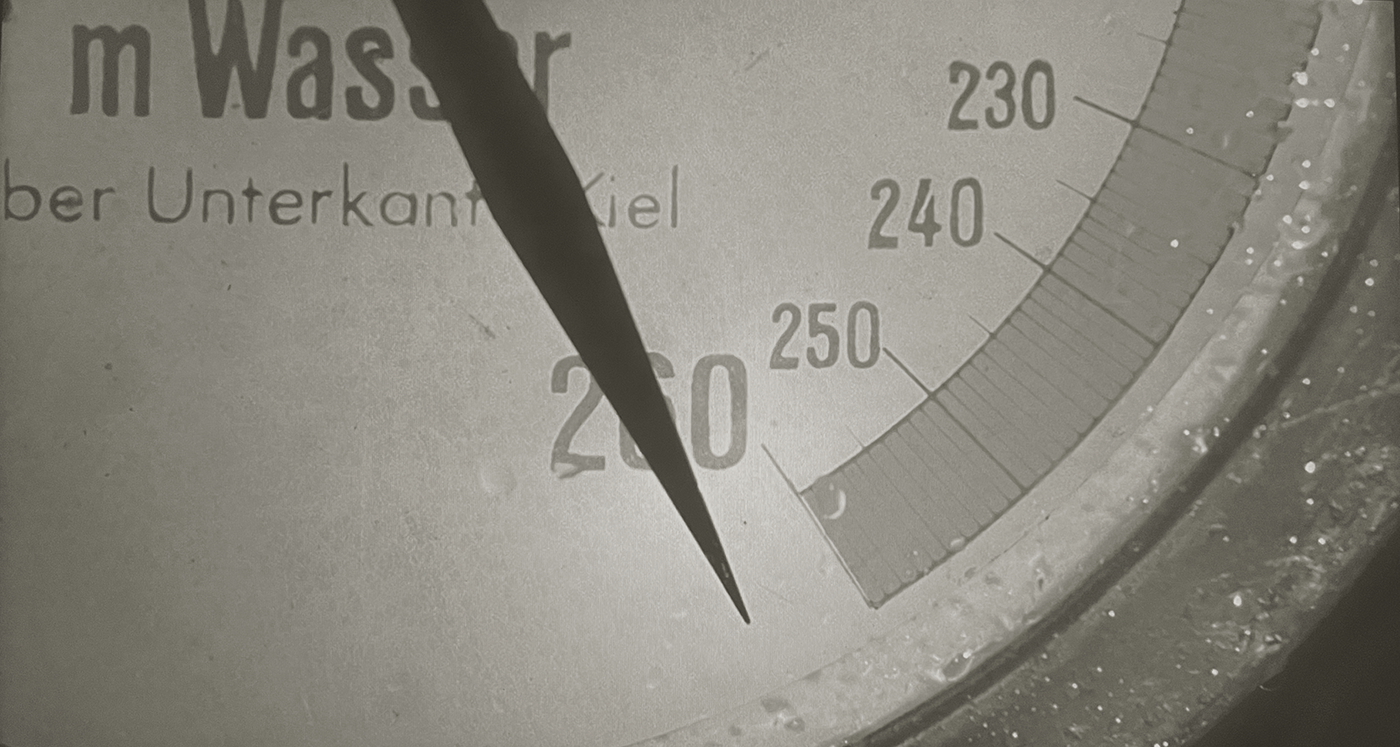
The result would be either to successfully reaching the desired depth, to having to stop early for repairs after an incident, to losing control of the boat, and possibly sinking. In any case, the Commander would take every measure to ensure the best possible outcome.
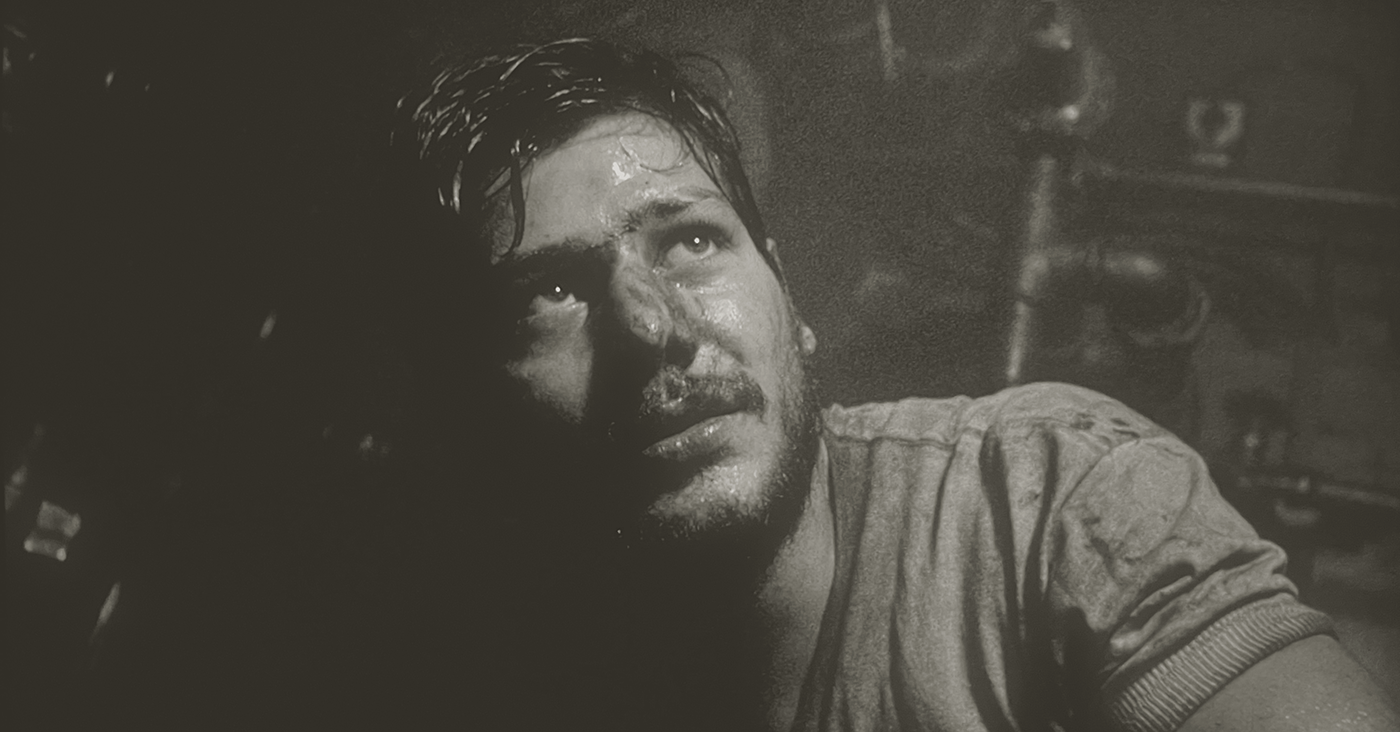
I think this system fits the game’s vision; it’s an iconic, believable point of view, leaving a lot to the player’s imagination. It recreates a powerful U-boat fantasy. And It’s a reasonable technical challenge, which allows to cover many situations without the need for a lot of unique assets and complex animations.
1-bit Art 101
First thing is to build the depth meter panel. It’s the backbone of the diving sequence, with characters making occasional comments as seen in other parts of the game.
I never conceived these devlogs as tutorials. The objective is to document every step of the process, to share the successes and the difficulties, and to get feedback. However, I received a number of requests to demonstrate my approach to 1-bit art, in particular the everlasting question of dithering.
The diving sequence screen is a good candidate for a modest step by step, as it covers many of the techniques I normally use. It’s nothing special nor new, but since there seems to be an interest, I’m happy to share. Apologies in advance for stating the obvious.
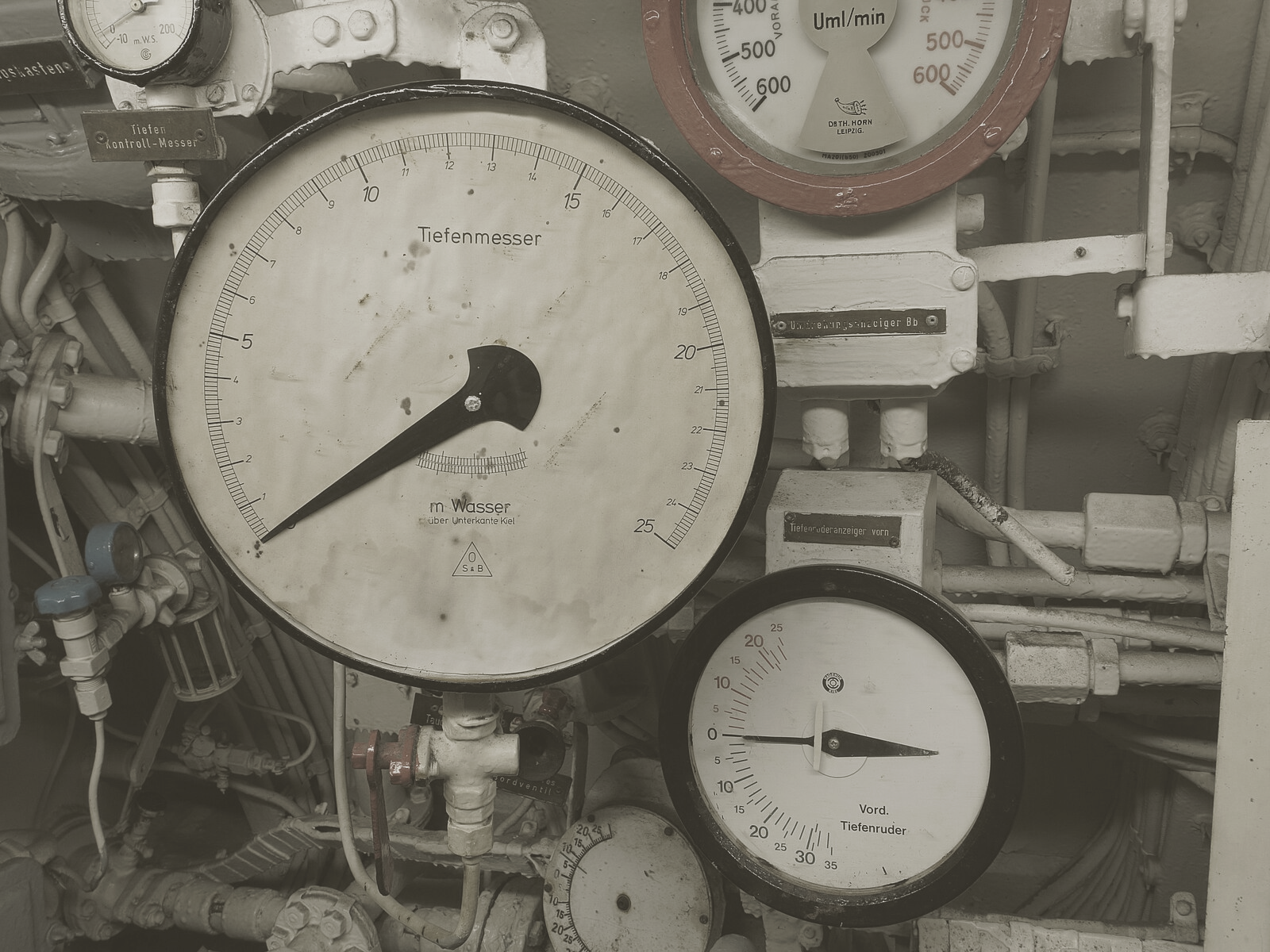
Reference of a Type VII Depth gauge
1/ Reference
If you’ve read my previous logs, you know that I would never consider making art for the game without looking for references, no more than I would design any feature without technical and historical research.
I chose to base my depth gauge on the Type VIIc’s, which was by far the most common U-boat. As time allows, I may try to make a dedicated screen per submarine type. I use the reference as a guide, not aiming for 100% accuracy, but trying to convey the essence of the subject.
2/ Blockout
I learned the hard way about the importance of the blockout phase. Forgive me for the banalities: a successful image requires a solid foundation. But many of us know the temptation of skipping the blockout to jump straight into the fun, rendering job. In my experience, it’s hard, if not impossible, to salvage a weak foundation. Unbalanced compositions, poor values break out, unpleasant shapes, all carry throughout the rest of the work, in spite of the artist’s best efforts to patch up the holes. The thing is: you can’t hide structural problems with cosmetic work.
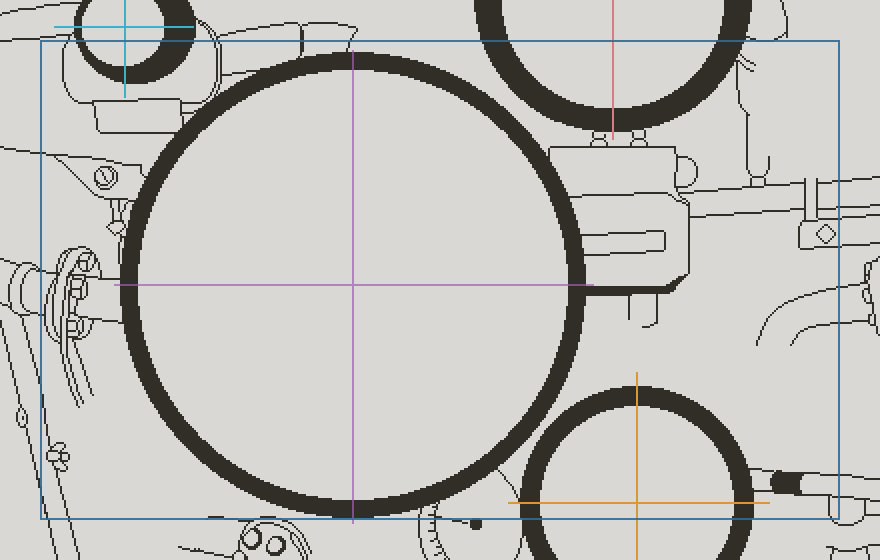
Block out
This may be even more essential with pixel art in general, and 1-bit in particular. High resolution, high color depth illustrations tolerate well rotation, scaling, opacity changes, and other large scale manipulations, which allow to make broad changes to composition and lighting, even at later stages. But for 1-bit art at the Playdate resolution, fundamental alterations often mean total redraw, because rotations mess up pixel perfect line art (see below), opacity doesn’t exist, and scaling mangles dithering patterns. I’ll show a few tricks to mitigate the damage, but late changes should be kept to a minimum.
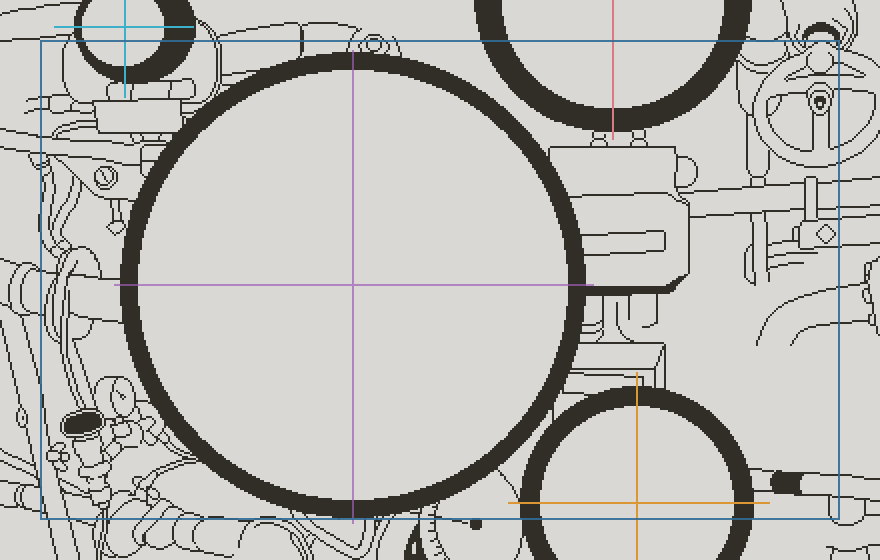
Line art in progress
Back to the depth gauge. First, I added 20 pixels of bleed all around the screen, for a total image resolution of 440 x 280. This will allow camera shakes. Along with crew member reactions and sound, the idea is to give visual and audio feedback about the situation. But I’ll come back to this.
Since everything revolves around the Tiefenmesser (depth meter), it should occupy as much real estate as possible. Consequently, I took liberties with the reference and adjusted the scale. Something to consider: real time image rotations hammer the performance to a point that I’ve always resorted to pre caching the rotations. In this case though, given its size, I need the depth pointer to rotate smoothly. At the refresh rate of the game (50 fps), this amounts to hundreds of images, and memory is comfortable but limited.
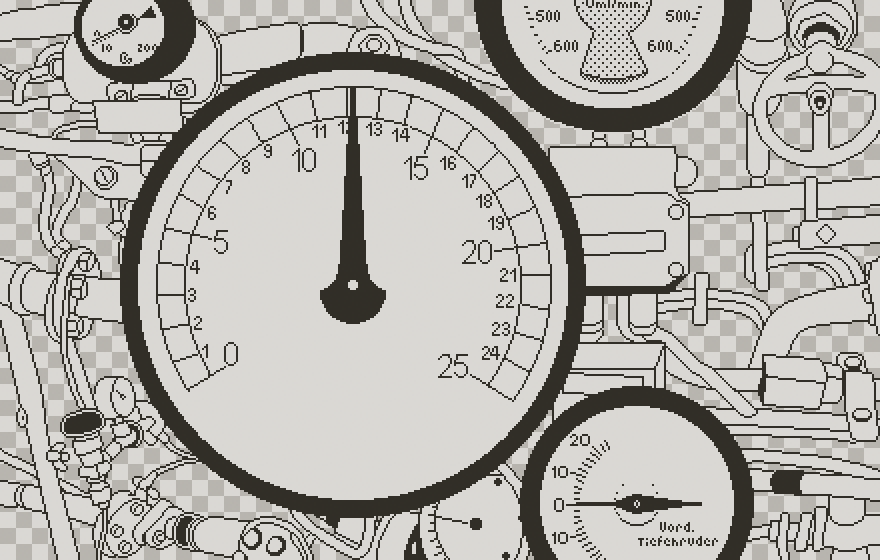
Line art complete and starting on dials
However, given how light the rendering and logic calculations are for the diving sequence, it’s worth giving the real time rotation a shot. Large, well defined, single colored shapes are the ideal candidates for a nice looking real time rotation, and the pointer fits that bill. The only issue is that camera motion forces a per frame redraw of the entire screen, not just the pointer, and I’m not sure how the Playdate will handle both.
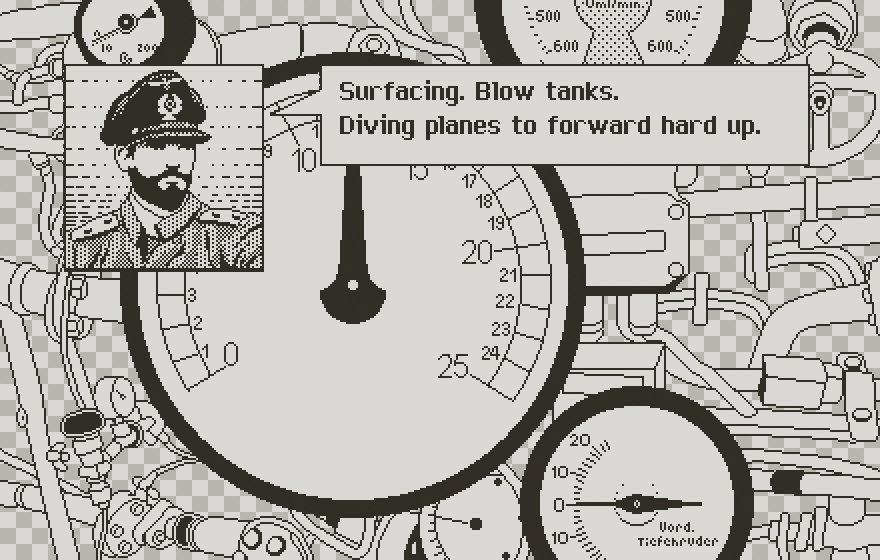
Testing the dialogue layout
Still, whether I pre cache or not won’t affect the background screen, and I can safely proceed with the art. The rest of the blockout is straightforward. I liked the left heavy composition of the reference, which the dialogue boxes, offset to the right, will nicely balance. I place a few other gauges, which will remain mostly inert. Then I fill in the space with a combination of pipes, levers and other mechanical gizmos, combining the various references.
3/ Gauges detail and line art
With the blockout complete, I begin to draw the details for the gauges, first of which is the all important Tiefenmesser. I find that starting with the focal point of the image allows me to give my best work for what matters, when the idea is still fresh and exciting. That way I ensure that, should I grow tired of the work, the less important stuff will suffer.

Detailing the gauges
A few things worth mentioning:
. I make sure that the gauges have thick black frames around light dials, because the highest contrast attracts the eye.
. I find important to try and minimize the aliasing effect by drawing as many clean lines as possible. Clean lines are mathematically pure. For instance straight lines with constant steps, perfect 45 degree angles, or curves with steps changing at a linear rate. See the few examples below. With experience, it becomes second nature. Careful not to overdo this though, as it may give a stiff, unnatural look to the art. It’s okay, and even preferable, to balance the geometric lines with a few imperfect shapes.
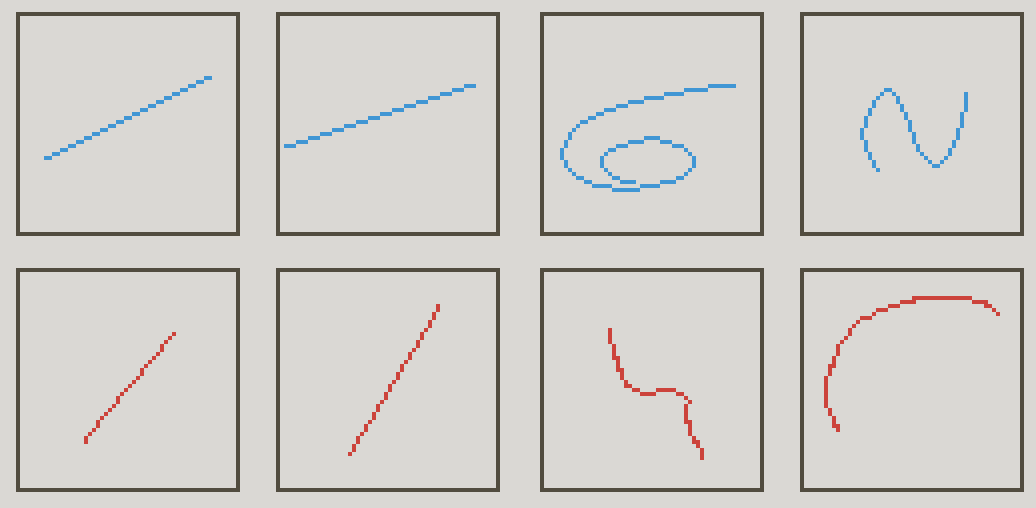
In blue, perfect shapes
. At this line stage, I try to suggest a sense of form and perspective, even though shading will do the heavy lifting. But overlapping shapes and converging lines can convey an impression of depth.
. I mentioned this for the tactical chart already; I deliberately draw seemingly important things (like small gauges) at the edge of the screen. Clipping suggests that there’s life outside the frame.
4/ Basic values
This is where things get interesting, and sometimes tricky. One notion that helped me: it’s easy to get lost at this stage when you don’t have a clear objective in mind. I like to think of dithering as a way to convey values, and by extension lighting. Sometimes, dithering suggests texture or material. The point being, I avoid detail for the sake of detail.
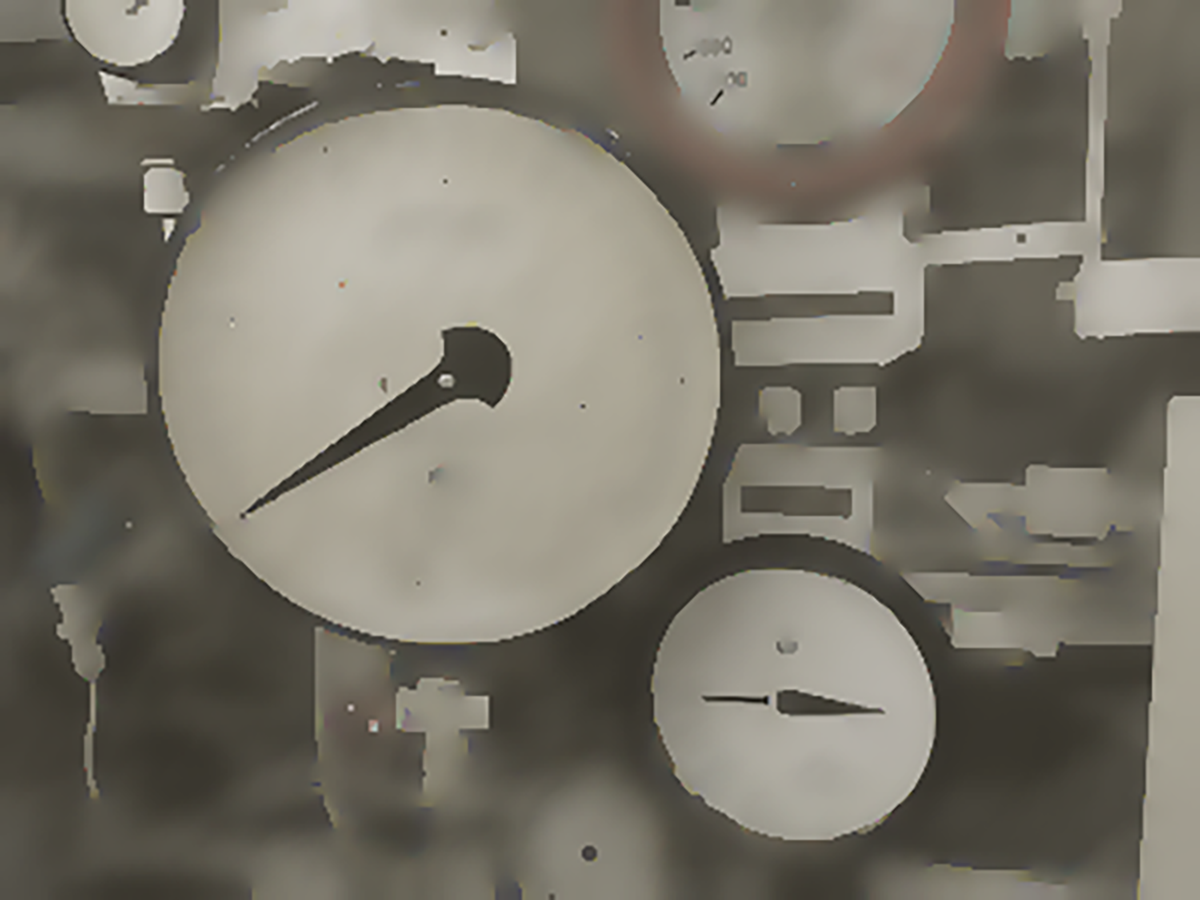
Removing details helps to understand the main values
A key observation in the reference is how the Tiefemesser seems closer to the camera, while the other instruments and mechanical bits recede in the background. It’s a good basis for lighting, since it favors looking at the gauge itself, and should help with making the image more legible.

Base patterns
With that in mind, I start to fill in the line art with dithering patterns. 90% of my images make use of the same eight to ten patterns, which make a gradient of values, from off white to dark grey. I find that using layer masks in Photoshop is the most convenient method. I fill in the entire screen with a pattern, and reveal the parts I want by painting in the layer mask. Most digital painting tools have masks, so this technique is transferable to your preferred software.
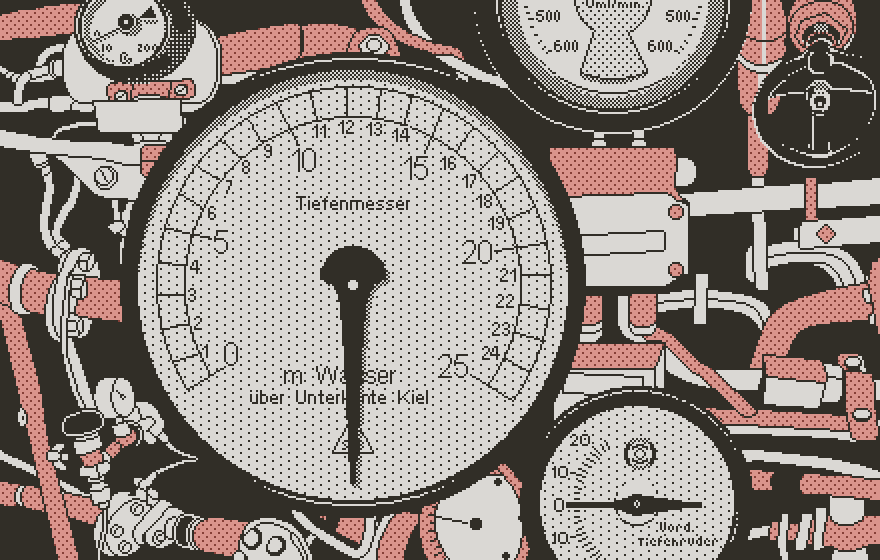
In red, the mask of the lightest pattern
Using masks has a number of advantages:
. It’s quick and flexible. You paint with white or black in the mask, and you don’t have to worry about the pattern. Nothing is ever set, since you don’t paint the pattern itself, but the mask. Reveal hidden parts or hide filled in areas at will.
. You can change, move around, rotate or mirror the pattern independently of the mask, allowing to try for different looks or values while preserving the affected areas.
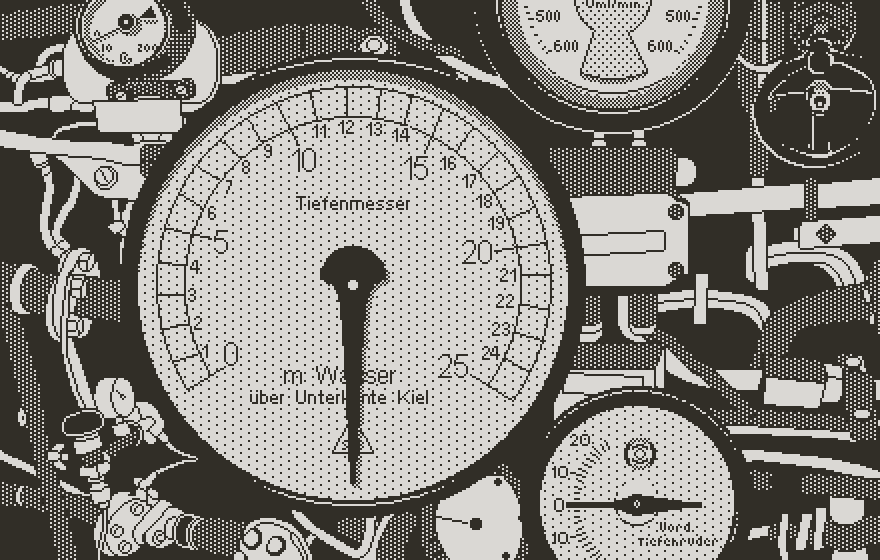
Copy the mask to a different pattern to quickly try a darker value
. You can select a mask and use that selection to paint into the mask of another pattern, which means that you can quickly replace certain areas with a different pattern. For instance, fill in a pipe with a mid grey pattern. They in that same selection, paint the brighter areas of the pipe in the mask of a lighter pattern, effectively shading the pipe.
. You can select a mask, nudge it, and apply that mask to a darker pattern, creating the illusion of a cast shadow.
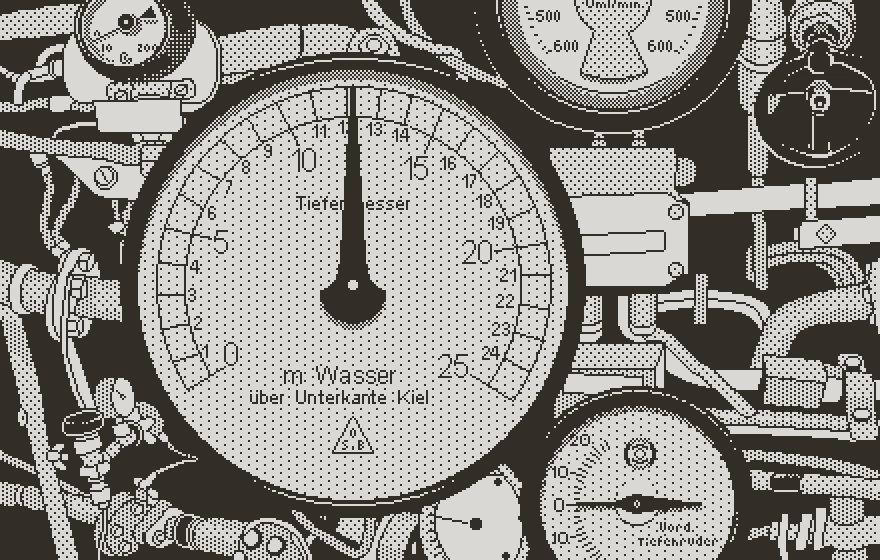
Adding values
In that example, I fill in the line art one pattern at a time, starting with the lighter value, and working my way down the darker values. To decide which pattern to use, I try to suggest overlapping shapes, creating a sense of depth. The more elevated parts will receive the light patterns, while the deepest areas get the dark patterns.
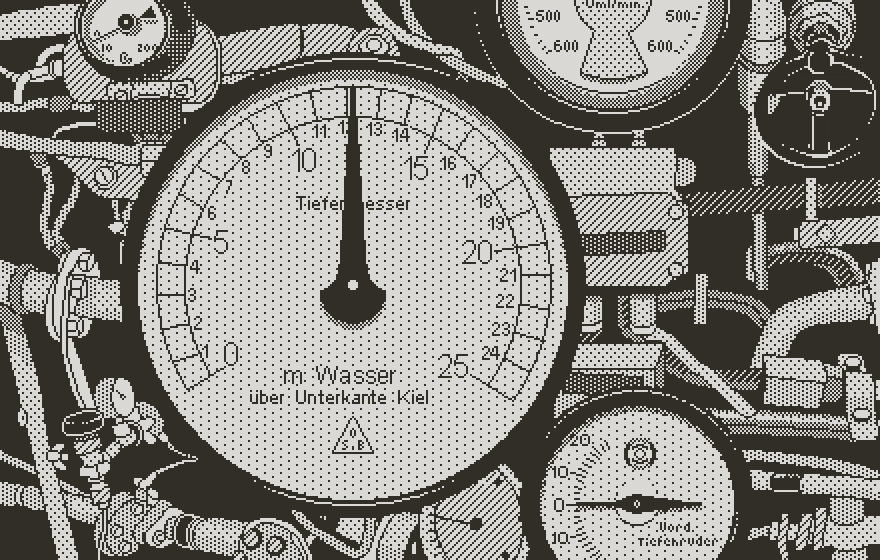
All patterns filled in
All my patterns use various combinations of dots, except for one, which has parallel lines. I find that useful to simulate a different texture. It also breaks the monotony of the dotted patterns. You can experiment with various fancy looking patterns. However these motifs tend to make the image busier and harder to read, so use your best judgement.
5/ Shadows
At this point, all the individual parts are in place, with basic shading and textures. But the image looks flat. If you squint, or zoom back, everything appears to be on the same level, sharing similar values. The wall lacks the depth from the reference. As a consequence, they eye wanders around, incapable of resting on a specific area.
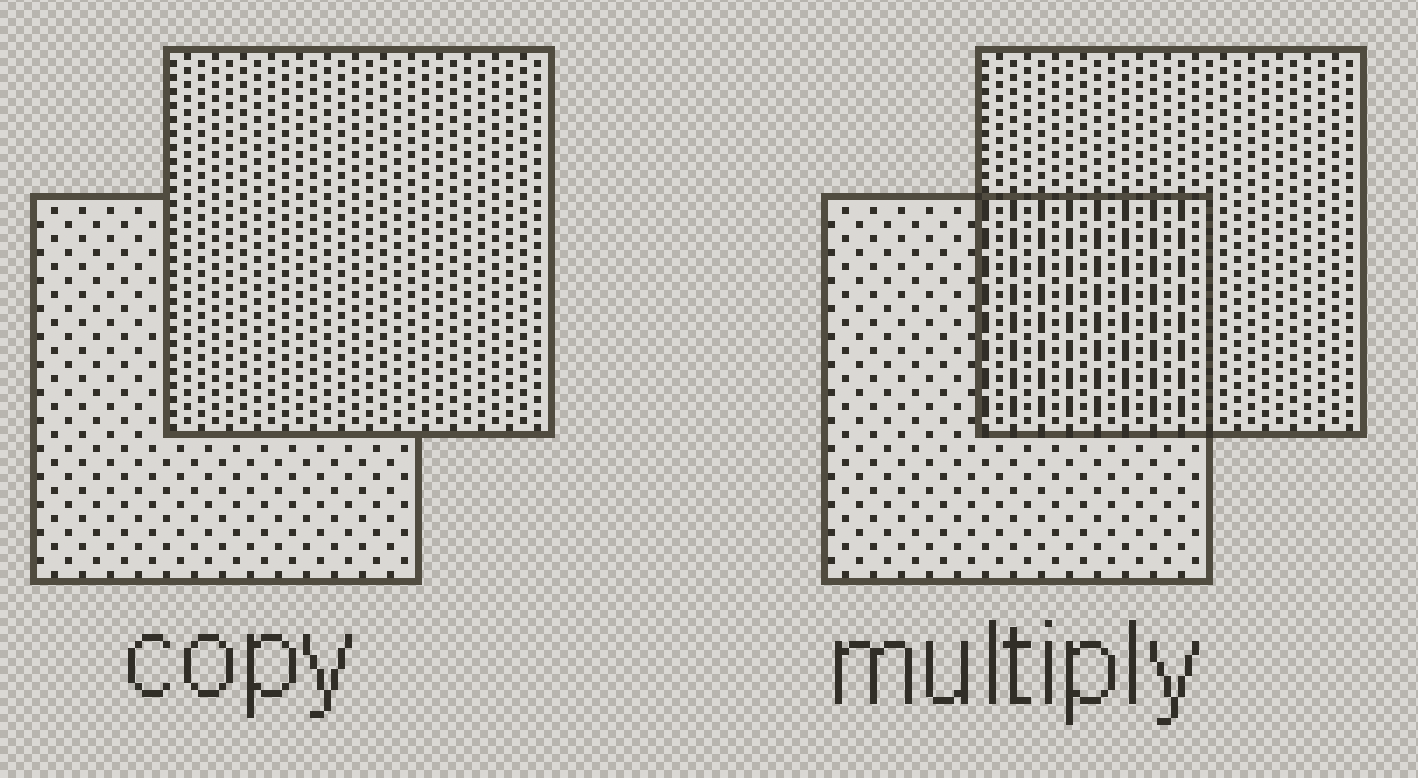
Copy and multiply blending modes
To remedy that, I need to add another level of lighting, with large shadows pushing areas down into darkness, so that the lightest parts seem to pop by contrast. But I don’t want to erase the underlying work with a darker value. To retain the shading and texturing work already done, I must mix the shadows with the artwork underneath. That’s where blending modes come in play.
In Photoshop, you can assign blending modes to layers. The normal blending is copy, in which the pixel value of the layer overrides the value of the underlying pixel. But you can instead multiply the layer with the underlying work (you guess it, in multiply mode). A black pixel has a value of zero, and white is one. This means that black pixels force the underlying pixels to black (0 x 0 = 0, and 0 x 1 = 0), and the white pixels don’t affect the underlying pixels (1 x 0 = 0, and 1 x 1 = 1). That’s perfect for shadows, as it blends the patterns in a way that seems to darken the image.
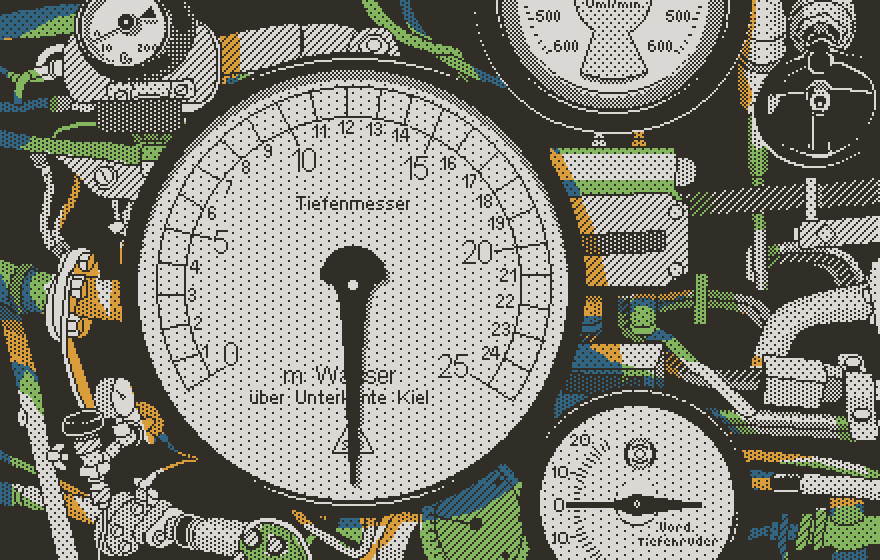
In Yellow and green, the two levels of shadows. In dark blue where they blend
I like to play with a couple of different patterns in multiply mode, creating new darker patterns. But it gets even more interesting if you combine this with the layer masks.
For instance, I’ll start to paint the deep shadow areas in the mask of a multiplied pattern. Then by applying that mask to different kinds of patterns, I can quickly try different pattern effects for shadows.
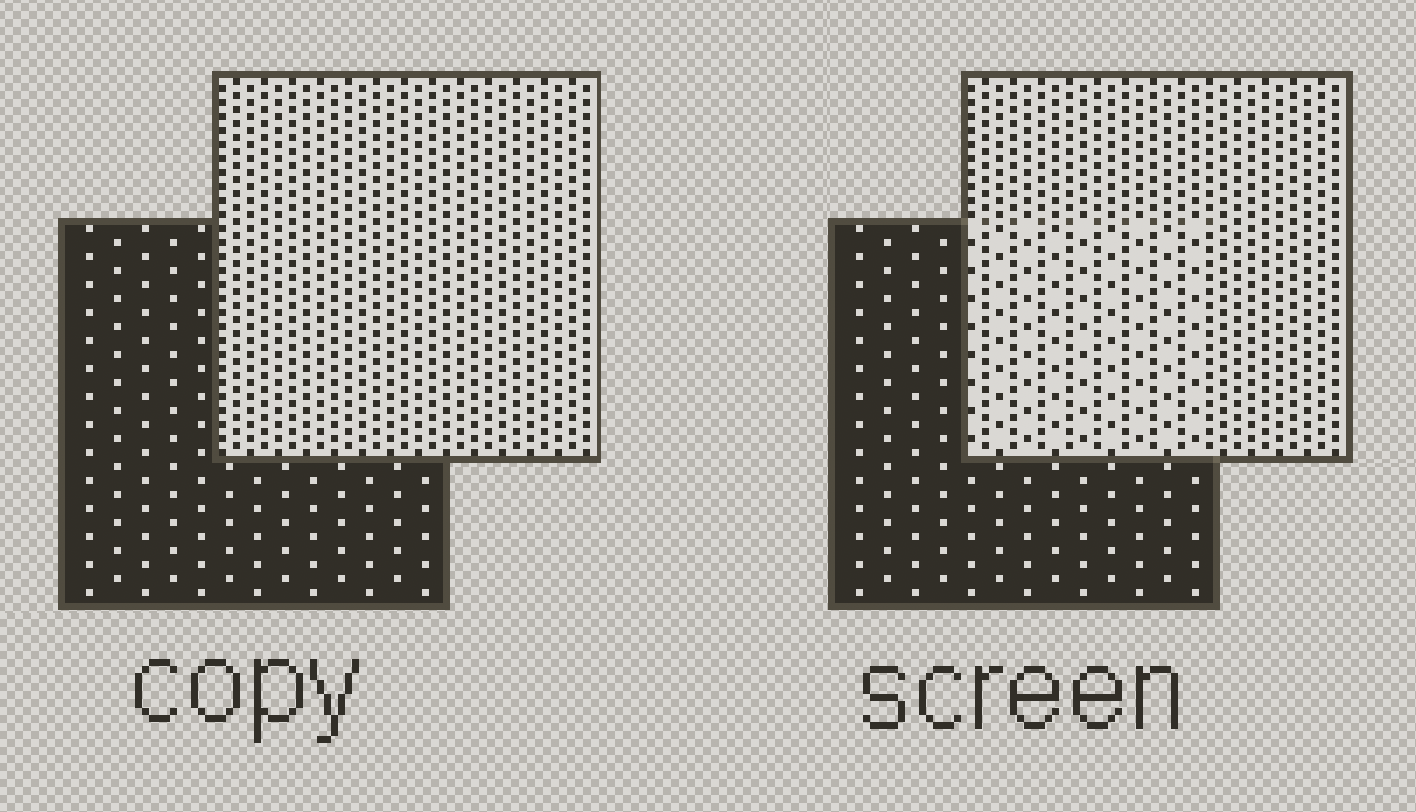
Copy and screen blending modes
You can create the opposite effect with screen mode, which adds pixels. In screen mode (sometimes called additive), a white pixel forces the underlying pixel to white (1 + 0 = 1, and 1 + 1 = 2 which clips to 1), while a black pixel has no effect (0 + 0 = 0, and 0 + 1 = 1). As a result, the new pattern brightens what’s underneath. In other words, blending modes make up for a crude 1-bit opacity system.
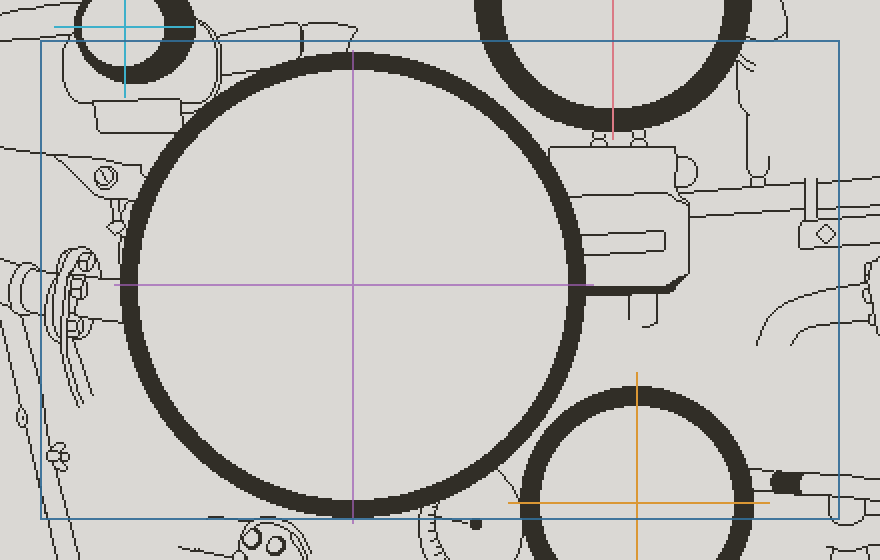
Step by step
I used two levels of shadows for the final image. First, I created a vignette effect by darkening the image around the edges of the screen, and in a few areas in the center, for visual interest. This gives the impression of a localized lighting, with the rest of the control room being dimly lit.
Then I painted the darkest values to simulate cast shadows under the Tiefenmesser and the top gauge, conveying the harsh light of a bulb hitting the main panel, while the rest of the wall falls back into shadows.
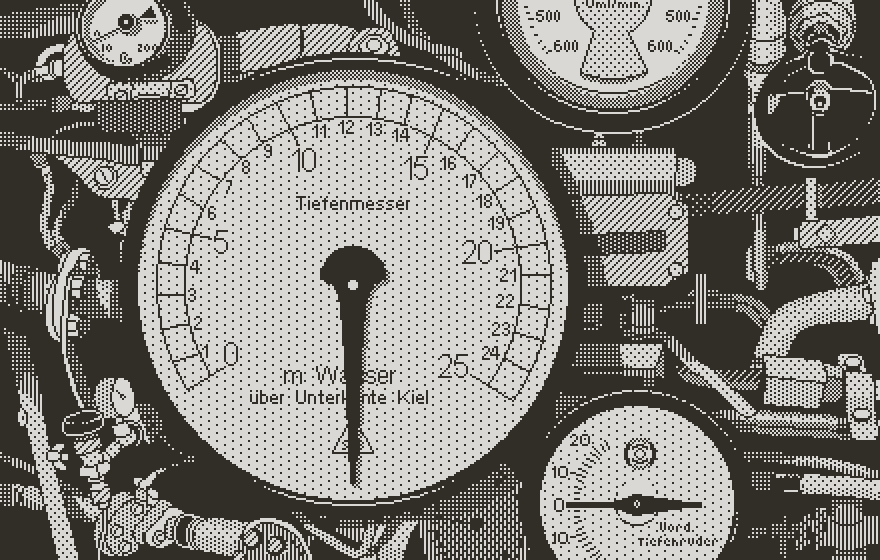
The final screen
Now the image works better. It’s more balanced and focused, and the eye tends to rest on the depth gauge. It has more large scale variations, which enhance visual interest and reduce noise.
This is just one example, but it sums up the majority of the techniques I use, which demonstrates how accessible 1-bit art really is.
The Stage Is Set
It’s been a long read, and I have even more to say about the sequence. Among the things to resolve:
. The under the hood calculations to determine the probability of an incident, and its nature. This is less trivial than it sounds. It must take into account a number of factors: depth, duration of dive, boat’s type and condition, crew experience, crew morale, urgency (crash dives are more prone to errors as they imply more stress), and officer’s perks.
. The frequency and type of comments delivered by the Chief and the Commander, contextual to the situation.
. Visual and audio feedback to convey water pressure on the submarine and other incidents, like running aground. I have ideas like camera shake, sounds of the superstructure bending and squeaking, rivets popping. And maybe small additional animations.
This is a lot to cover, so I invite you to join me for the next log, where I’ll conclude the diving sequence.
And for those of you who made it this far, here’s a peek at the progress. Unless you cheated and skipped to this point, which I would have done.
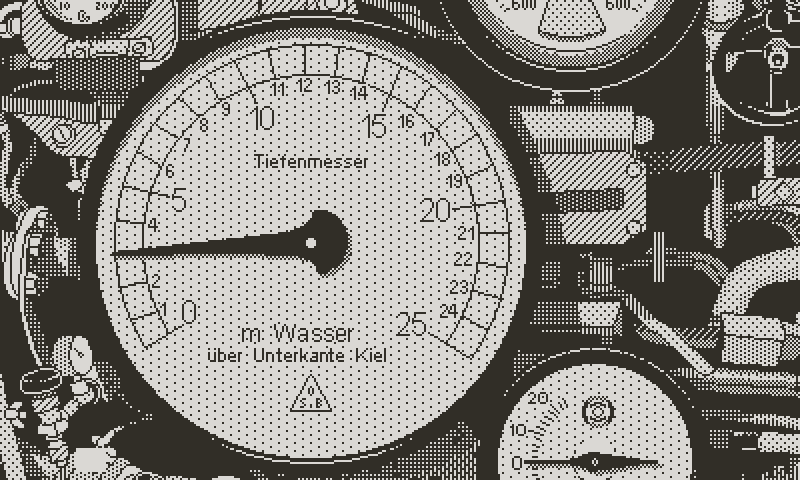
So, you know it, more soon.
Atlantic '41
A WW2 U-boat Simulation for the Playdate
| Status | In development |
| Author | StephanRewind |
| Genre | Simulation |
| Tags | 1-bit, Pixel Art, Playdate, Turn-based Strategy, World War II |
More posts
- The Enemy (Part 1)15 days ago
- Los!61 days ago
- Preparing the FutureApr 07, 2025
- Project ResetApr 01, 2025
- Small BeginningsFeb 24, 2025
- Death by a Thousand ShellsDec 17, 2024
- Next devlog a bit delayedOct 13, 2024
- First BloodAug 28, 2024
- An Important MilestoneMay 23, 2024

Comments
Log in with itch.io to leave a comment.
The depth gauge looks fantastic.
These updates are always really fun. Even the smallest challenge is taken very seriously and tackled with an extraordinary passion and energy.
I also appreciate the Aubrey-Maturin callback. I'm a huge Patrick O'Brian fan and I get a jolt of endorphins any time I come across even the most oblique reference. :)
I’m so glad that someone got the reference! I read a few books in the series, but I’m taking my time because I don’t want it to be over :)
Thank you for the kind feedback. Because I love working, it’s easy for me to indulge into every detail, and to forget how long the game has been in development. So I’m very thankful that everybody is so patient and supportive. Hopefully it will be worth it in the end.
These devlogs are a joy to read. Of course I want to get my hands on the game, but the downside is that I don't want the devlogs to end. ;)
Incidentally, I too would like to volunteer as a playtester if needed.
As for the Patrick O'Brian books, there are 20 of them, so it should take a while to get through all of them.
Thanks for offering your help. I’ll have a post here so you’ll be able to apply for beta testing. Don’t expect it to be anytime soon though :)
The background detail is incredible. You really nailed the gnarly bits and bobs in dim lighting.
I imagine there will be few opportunities to put that much background in other core scenes (given how much information you have to cram into them), but I hope there are at least a few more chances for zoomed-out views showing more machinery. Maybe for other events?
I’d love to see similar treatments of some of the other areas of the boat, like the steering wall in the control room, the engines, or even daily-life stuff like the galley and the head.
Or if there are views that don’t fit into the gameplay, perhaps there are other ways to work them in. Gameplay could unlock images in a browsable gallery, sort of like in Forrest Byrnes. Or pack-in art for a collector’s edition.
Like the other commenter, I get excited every time I’m notified of a new post. Thanks for continuing to write these.
Thank you :) you can absolutely count on seeing more areas of the boat. I have plans for at least the Hydrophone, and in the same place the radio/enigma. And then other things that I’d rather keep under wraps for now.
You’re right though: it will be a challenge to show larger rooms, as the amount of detail crammed into these may make the art difficult to read.
That is a wonderful post about many interesting things. I really do appreciate the you tell us how you dealt with 1bit graphics and shadowing. Very inspiring. Thanks !
Thank you! Glad this was of use :)
A great post. Some great insights into your reduction and refining of the core elements needed to pull off the tension and excitement of the diving gameplay.
Also much appreciate you sharing your process in working on the dial scene in 1bit.
Thank you very much. Initially I didn’t plan to have any tutorials but this was a bit different, as I got requests for it. But it’s tricky because I don’t want people to assume that I pretend to know what I’m doing ;)
This is my first comment on itch! I just wanted to tell you how thrilled I get every time I get the e-mail telling me there's a new dev-log out for this game. The effort and detail you've put into this project is truly incredible and I cannot wait to finally get my hands on it. I've never really been into military or ship combat games, but everything about this has me so excited. If you ever need a playtester I would be honored to give you feedback when you're ready for it to be tested by others.
This is so kind of you to say. Every encouragement I get makes the project so much more meaningful to me, and helps me going through the bits of doubt. In particular when it comes from people like you who aren’t into this kind of game.
When I’m ready to go into beta, I’ll leave a post here and you will have the opportunity to “apply”. I don’t know how many people I’ll get/need yet but I hope to have people covering the whole gamut of players, from simulation veterans to casual players.
I'm glad my encouragement can help you to keep pushing to make your game a reality. I know being an indie or small time developer can be quite difficult but, truthfully, there is nothing about this project you should be doubtful of. Playdate in my experience is the perfect platform for a game like this. It's something new and unique and niche on top of being incredibly well crafted, and for those reasons you've piqued the interest of a lot of the community with this project, especially those like myself who have never tried a hand at playing a game like this before. The Playdate is almost synonymous with playing games out of your comfort zone and trying new things. You couldn't have picked a better platform for this project, and I'm positive that when the time comes you'll have nothing but praise from every corner of the community. Keep up the amazing work, and don't forget to give yourself a break every now and again too!
You’re very kind. I agree that the Playdate seems to attract developers who like to tread outside the beaten path. In fact, from the get go I wanted to make something that you couldn’t find on any other platform, in particular portable; a serious simulation that anyone could play in short bursts and that wouldn’t require investing in a powerful computer.
I love simulations and strategy games in a historical setting, but it’s a domain almost exclusively reserved to PC, and I really miss playing this kind of game on the go. So hopefully Atlantic ‘41 will fill a void for people with similar interests and maybe get people like yourself to discover something new.
even if a hard time is not a good time, these logs have been a deligh
Thank you!